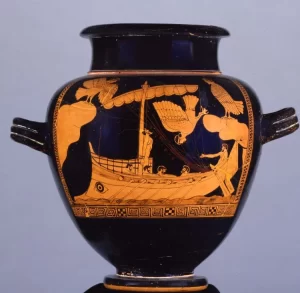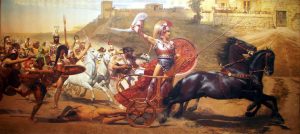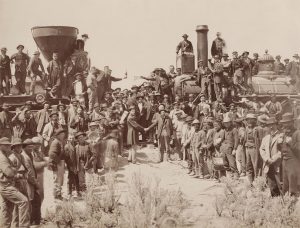Fall of the Western Roman Empire
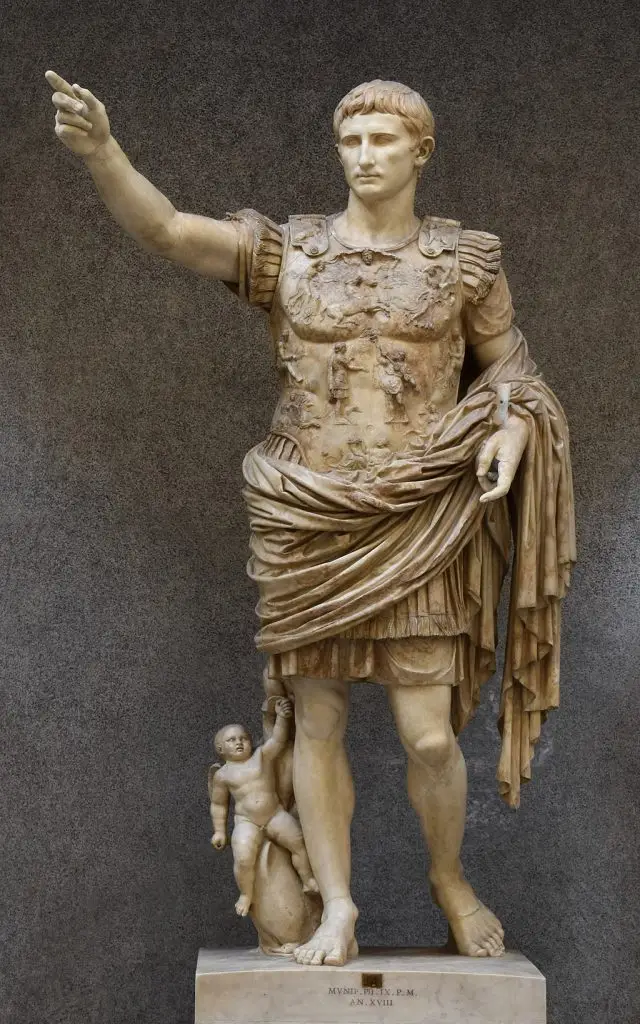
The Augustus of Prima Porta (Italian: Augusto di Prima Porta) is a full-length portrait statue of Augustus, the first Roman emperor.
(Wiki Image By Joel Bellviure – Own work, CC BY-SA 4.0, https://commons.wikimedia.org/w/index.php?curid=129823838)
Fall of the Western Roman Empire YouTube Video
- Ten Minute History – The Fall of Rome (Short Documentary) by History Matters
- URL: http://www.youtube.com/watch?v=EIkeRBP5nDg
- Views: 3,672,186
- What Caused the Fall of the Western Roman Empire? by World History Encyclopedia
- URL: http://www.youtube.com/watch?v=RkPjf01oOdk
- Views: 117,653
- What Caused the Roman Empire to Collapse by The Infographics Show
- URL: http://www.youtube.com/watch?v=5tilhR0C6DY
- Views: 4,217,481
- Did the Romans Know the Empire Was Falling? by Kings and Generals
- URL: http://www.youtube.com/watch?v=jMwt9zOFX2I
- Views: 857,113
- Fall of The Roman Empire…in the 15th Century: Crash Course World History #12 by CrashCourse
- URL: http://www.youtube.com/watch?v=3PszVWZNWVA
- Views: 8,845,558
Gibbon’s History of the Decline and Fall of the Roman Empire
The Fall Of Ancient Rome: The Events That Ended The …
03 – Caesar And Christ – Durant, Will
Fall of the Western Roman Empire Books
For a single, definitive book on the fall of the Western Roman Empire, the best modern choice is “The Fate of Rome: Climate, Disease, and the End of an Empire” by Kyle Harper.
The collapse of the Roman Empire is one of the most studied and debated topics in all of history. Here are some of the most essential books for understanding this complex process.
The Definitive Modern Overviews
“The Fate of Rome: Climate, Disease, and the End of an Empire” by Kyle Harper. This is a groundbreaking and highly acclaimed modern history that fundamentally shifted the debate. Harper argues that the primary drivers of Rome’s collapse were not just political or social but environmental. He marshals evidence from climate science and genetics to show how catastrophic pandemics and a changing climate fatally weakened the empire, making it vulnerable to barbarian invasions and internal fractures.
“The Fall of the Roman Empire: A New History of Rome and the Barbarians” by Peter Heather. This is another leading modern interpretation. Heather argues that the fall was not a story of internal decay but was caused by external shocks. He contends that the arrival of the Huns in Central Europe in the 4th century triggered a massive “domino effect,” forcing Germanic tribes like the Goths to violently migrate into a Roman Empire that was still relatively strong but ultimately overwhelmed by the scale of these invasions.
The Classic, Foundational Work 🏛️
“The History of the Decline and Fall of the Roman Empire” by Edward Gibbon. First published in 1776, this is the most famous and influential history book ever written in English. Gibbon’s monumental work is a masterpiece of literature and a foundational text of modern historiography. While many of his specific arguments (famously, his blaming of the rise of Christianity) have been challenged by modern research, his grand narrative and magisterial prose have shaped our understanding of the fall of Rome for over 200 years. Abridged versions are available for those not wishing to tackle all six volumes.
For a Broader “Late Antiquity” Perspective
“The World of Late Antiquity: AD 150-750” by Peter Brown. This is a classic and highly influential book that redefined the entire period. Brown argues against the idea of a sudden, catastrophic “fall” in 476 AD. Instead, he presents the era as a long, slow transformation from the classical Roman world to the new worlds of Byzantine Christendom and Islam. It’s less about collapse and more about a complex period of cultural and religious change.
Fall of the Western Roman Empire: History
You’re interested in the factors that contributed to the Fall of the Western Roman Empire! It’s a complex topic with many contributing factors, and historians continue to debate their relative importance:
Political and Administrative Issues
- Political Instability and Corruption: Frequent changes in leadership, civil wars, assassinations, poisons, or murders weakened the empire and eroded public trust.
- Ineffective Leadership: Many later emperors lacked the competence and leadership skills to govern the vast empire effectively.
- Overexpansion and Overextension: The empire became too large to manage effectively, straining resources and communication.
- Bureaucratic Inefficiency: The bureaucracy became bloated and inefficient, hindering effective governance and decision-making.
- Division of the Empire: The division of the empire into Western and Eastern halves created administrative challenges and weakened its overall strength.
- Corruption and Greed: Corruption within the government and ruling class diverted resources and weakened the empire’s administration.
- Loss of Senatorial Power: The Senate, once a powerful governing body, lost influence and authority, leading to a decline in effective governance.
- Military Interference in Politics: The military increasingly interfered in politics, leading to instability and civil wars.
Economic and Social Factors
- Economic Decline: Inflation, high taxes, and a decline in trade weakened the economy and created social unrest.
- Overreliance on Slave Labor: The reliance on slave labor discouraged technological innovation and created economic imbalances.
- Social Inequality: The gap between the rich and the poor widened, leading to social tensions and unrest.
- Decline in Civic Virtue: A decline in civic responsibility and participation weakened the social fabric of the empire.
- Loss of Patriotism: Citizens became less invested in the empire’s well-being, leading to decreased military recruitment and civic engagement.
- Urban Decay: Major cities experienced overcrowding, poverty, and infrastructure decline.
- Agrarian Crisis: Land ownership became concentrated in the hands of a few wealthy individuals, leading to rural poverty and a decline in agricultural production.
Military Challenges
- Barbarian Invasions: Repeated invasions by Germanic tribes and other groups put immense pressure on the empire’s borders and military resources.
- Military Overspending: Maintaining a large and far-flung military became increasingly expensive, draining the empire’s finances.
- Decline in Military Discipline: The Roman legions, once renowned for their discipline and effectiveness, suffered from declining morale and training standards.
- Recruitment Difficulties: The empire struggled to recruit and maintain a strong military force, relying increasingly on foreign mercenaries.
- Loss of Military Technology: The Roman military lost its technological edge, failing to keep pace with its enemies’ innovations.
- Lack of Vision and Strategic Thinking: Many emperors lacked a long-term vision for the empire and focused on short-term gains or personal ambitions.
- Rise of New Powers: The emergence of powerful new empires, such as the Sassanian Empire in Persia, challenged Roman dominance.
- Sack of Rome by the Visigoths (410 AD): This event shocked the Roman world and symbolized the decline of Roman power.
- Deposition of Romulus Augustulus (476 AD): The Germanic chieftain Odoacer deposed the last Western Roman Emperor, traditionally marking the end of the Western Roman Empire.
Cultural and Religious Changes
- Rise of Christianity: The spread of Christianity challenged traditional Roman values and religious practices, contributing to social and political divisions.
- Loss of Traditional Values: The decline of traditional Roman values, such as civic duty and military discipline, weakened the social fabric of the empire.
- Loss of the Virtue of “Pietas”: Traditional Roman respect for gods, family, and the state diminished.
- Cultural Decline: A decline in intellectual and artistic achievements contributed to a sense of stagnation and decline.
- Bread and circuses: The focus on entertainment and appeasement of the masses led to a decline in public morale and civic engagement.
- Spread of Eastern Religions: The influence of Eastern mystery religions and philosophies contributed to a decline in traditional Roman religious practices.
- Moral Decay: Some historians point to a decline in moral values, increased decadence, and corruption contributing to the empire’s decline.
External Factors
- Climate Change: Climatic changes, such as droughts and crop failures, contributed to economic hardship and social unrest.
- Disease and Plagues: Epidemics like the Antonine and the Cyprian Plague decimated the population and weakened the empire.
- Natural Disasters: Natural disasters like earthquakes and volcanic eruptions cause disruption and economic hardship.
- Deforestation: Extensive deforestation led to soil erosion and environmental degradation, impacting agriculture and the economy.
- Lead Poisoning: Some historians argue that lead poisoning from lead pipes and utensils contributed to health problems and a decline in cognitive abilities within the Roman population.
It’s important to note that these factors are interconnected and interact in complex ways to contribute to the fall of the Roman Empire. Historians continue to debate the relative importance of each factor, but it’s clear that the decline was a gradual and multifaceted process that spanned centuries.
Political and Administrative Issues
Fall of the Western Roman Empire. Political Instability and Corruption: Frequent changes in leadership, civil wars, assassinations, poisons, or murders weakened the empire and eroded public trust. Table. Examples.
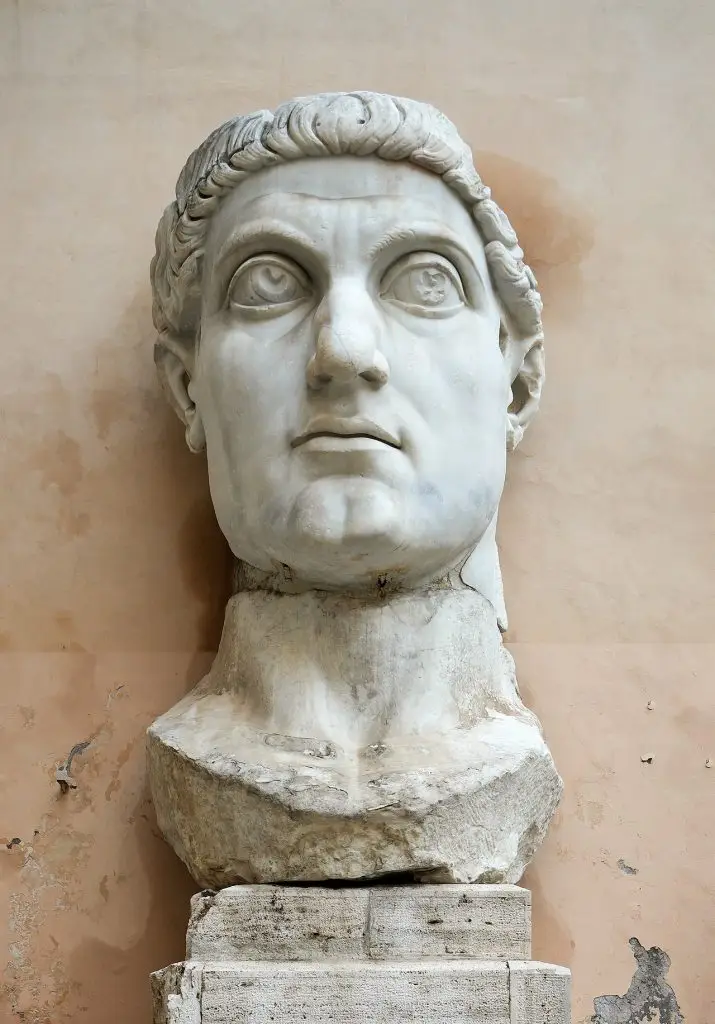
Head of the Colossus of Constantine, Capitoline Museums
(Wiki Image By Merulana – Own work, CC BY-SA 4.0, https://commons.wikimedia.org/w/index.php?curid=126701466)
You’re right. Political instability and corruption were significant factors that gnawed away at the foundations of the Western Roman Empire, ultimately contributing to its downfall. Let’s create a table to illustrate this:
The Fall of the Western Roman Empire: Political Instability and Corruption
| Aspect of Political Instability/Corruption | Description | Examples in the Late Western Roman Empire (c. 3rd-5th Centuries AD) |
| Frequent Changes in Leadership | Emperors were rapidly overthrown, assassinated, or died under suspicious circumstances, leading to a lack of continuity and effective governance. | The Crisis of the Third Century (235-284 AD): More than 26 emperors ruled in 50 years, most of whom were generals who seized power through force and were quickly overthrown. For example, Emperor Maximinus Thrax was assassinated by his troops. Emperor Gordian III was likely killed by his successor, Philip the Arab. |
| Civil Wars | The empire was plagued by frequent civil wars between rival claimants to the throne, draining resources and manpower. | Constantine I’s rise to power: Constantine fought civil wars against Maxentius and Licinius before becoming sole emperor. The later empire: Civil wars erupted throughout the 4th and 5th centuries, weakening the empire. For example, after the death of Theodosius I, the empire was divided between his sons. The west was controlled by Honorius, who was controlled by a general, Stilicho. There were several attempts to overthrow Honorius. |
| Assassinations, Poisonings, and Murders | Political rivals were often eliminated through violence, creating a climate of fear and mistrust. | Many emperors met violent ends. Examples: Emperor Commodus was strangled by a wrestler in his bath. A soldier assassinated Emperor Caracalla. Emperor Elagabalus was killed, along with his mother, by the Praetorian Guard. Emperor Valentinian III was assassinated. Several emperors were killed in battle or executed after losing battles. Generals in Control General Stilicho (who was Vandal) was suspected of plotting with Alaric the Goth and executed. General Aetius was murdered by Emperor Valentinian III, weakening the Western Roman Empire. General Arbogast (who was Frank) had Emperor Valentinian II killed and appointed a puppet emperor. General Ricimer (who was Suebi-Goth) made and unmade several emperors. |
| Corruption in Government | Bribery, extortion, and favoritism were rampant in the bureaucracy, undermining the rule of law and eroding public trust. | Tax farming: The tax collection system was often corrupt, with tax farmers (publicani) extorting more than was owed from the population. Sale of offices: Government positions were usually bought and sold rather than awarded on merit. Judicial corruption: Judges could be bribed, leading to unfair legal outcomes. Examples: Emperor Pertinax attempted to reform the bureaucracy but was quickly assassinated. Later, emperors were often unable or unwilling to control corruption. |
| Decline in Civic Virtue | The traditional Roman values of duty, public service, and patriotism declined, replaced by self-interest and a focus on personal gain among the elite. | The wealthy increasingly evaded taxes and used their influence to avoid military service. Many sought to enrich themselves at the state’s expense, contributing to the decline of public morality. Example: Once an influential and respected institution, the Roman Senate became increasingly ineffective and self-serving in the later empire. |
| Military Interference in Politics | The army played an increasingly dominant role in politics, making and unmaking emperors according to its interests. | The Praetorian Guard, originally the emperor’s bodyguard, frequently assassinated emperors and installed their candidates. Later, generals from the provinces used their armies to seize power, leading to further instability. Examples: The Year of the Four Emperors (69 AD) and the Crisis of the Third Century saw numerous generals proclaimed emperor by their troops. |
| Impact on the Empire | Weakened central authority: The constant power struggles and lack of stable leadership made it difficult to govern effectively. <br> Eroded public trust: Corruption and violence undermined faith in the government and the rule of law. <br> Diverted resources: Civil wars and internal conflicts drained the empire’s resources and manpower, making it more vulnerable to external threats. <br> Inability to respond to crises: The unstable political situation made it difficult for the empire to respond effectively to economic problems, barbarian invasions, and other challenges. | The combination of these factors created a vicious cycle of decline. Political instability led to economic problems, social unrest, and military weakness, further exacerbating political instability. This made it impossible for the Western Roman Empire to recover from its various crises in the 4th and 5th centuries. |
Export to Sheets
In Conclusion:
Political instability and corruption were not just symptoms but also major contributing factors to the decline of the Western Roman Empire. Constant power struggles, civil wars, assassinations, and widespread corruption severely weakened the empire from within, making it increasingly difficult to govern effectively, maintain order, defend the borders, and address mounting economic and social problems. This internal decay and external pressures from barbarian migrations and invasions ultimately proved fatal to the Western Roman Empire.
The Fall of the Western Roman Empire. Ineffective Leadership. Many later emperors lacked the competence and leadership skills to govern the vast empire effectively. Table. Examples.

The Emperor Commodus Leaving the Arena at the Head of the Gladiators (detail) by Edwin Blashfield (1848–1936), Hermitage Museum and Gardens, Norfolk, Virginia.
(Wiki Image By Edwin Howland Blashfield – https://hermitagemuseum.wordpress.com/2011/10/14/on-commodus/, Public Domain, https://commons.wikimedia.org/w/index.php?curid=84766891)
You’re right to pinpoint ineffective leadership as a significant factor in the Roman Empire’s decline. Many emperors who came to power in the later years simply lacked the skills or the will to rule effectively. This had a ripple effect, weakening the empire from the inside out.
Here’s a table with examples of ineffective Roman emperors and how their shortcomings contributed to the fall:
| Emperor | Reign | Examples of Ineffective Leadership & Effects |
| Commodus | 177-192 AD | – Self-indulgent and cruel: More interested in gladiatorial combat and personal pleasures than governing. <br> – Neglected state affairs: Allowed corruption and mismanagement to flourish, leading to economic instability and social unrest. <br> – Paranoid and tyrannical: Executed perceived enemies and rivals, creating a climate of fear and undermining trust in the government. |
| Elagabalus | 218-222 AD | – Eccentric and out of touch: Focused on promoting his Syrian sun god and engaged in bizarre religious practices, alienating the Roman people and the Senate. <br> – Incompetent and unstable: Lacked the skills and experience to govern effectively, leading to chaos and instability. <br> – Moral decline: His scandalous behavior and disregard for Roman traditions further eroded public morality and confidence in leadership. |
| Honorius | 395-423 AD | – Weak and indecisive: Failed to address the growing threats to the Western Roman Empire, retreating to Ravenna while the Visigoths sacked Rome. <br> – Reliance on others: Heavily reliant on his generals and advisors, who often pursued their agendas, leading to further instability and ineffective governance. <br> – Loss of territory: His inability to defend the empire led to significant territorial losses and the weakening of Roman authority. |
| Romulus Augustulus | 475-476 AD | – Puppet emperor: A mere figurehead installed by his father, the general Orestes. He lacked any real power or authority. <br> – Symbol of decline: His deposition by the barbarian general Odoacer marked the end of the Western Roman Empire, symbolizing the ultimate failure of leadership and the collapse of Roman authority. |
Export to Sheets
Overall Impact:
These examples illustrate how ineffective leadership contributed to the decline of the Roman Empire. Emperors who lacked competence, indulged in personal vices, or neglected their duties weakened the government, undermined public trust, and created instability. This made the empire vulnerable to internal strife and external threats, ultimately contributing to its downfall.
It’s important to note that there were also periods of strong leadership during the Roman Empire. However, the overall trend in the later years was toward a decline in the quality of emperors, which played a significant role in the empire’s eventual collapse.
The Fall of the Western Roman Empire. Overexpansion and Overextension: The empire became too large to manage effectively, straining resources and communication. Table. Examples.
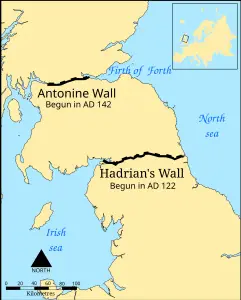
The location of Hadrian’s Wall in what is now northern England, and the later Antonine Wall in what is now the Central Belt of Scotland
(Wiki Image By Hadrians_Wall_map.png: Created by NormanEinstein, September 20, 2005derivative work: Talifero (talk) – Hadrians_Wall_map.png, CC BY-SA 3.0, https://commons.wikimedia.org/w/index.php?curid=15121382)
You’re focusing on a crucial aspect of the Roman Empire’s decline: overexpansion and overextension! As the empire grew, managing its vast territories and diverse populations became increasingly difficult, putting a strain on resources and communication. Here’s a table breaking down this contributing factor:
| Aspect of Overexpansion | Effects & Challenges |
| Geographic Extent | – Vast territory: At its peak, the Roman Empire encompassed vast territories across Europe, North Africa, and the Middle East. <br> – Effects: This made it incredibly difficult to administer, defend, and maintain control over such a large area. |
| Administrative Strain | – Complex bureaucracy: Managing diverse regions and populations requires a complex and extensive bureaucracy. <br> – Communication challenges: Communication and transportation across vast distances were slow and challenging, hindering effective governance. <br> – Example: Messages could take weeks or even months to travel from Rome to the distant provinces, making it difficult to promptly respond to crises or rebellions. |
| Military Overextension | – Defending borders: The empire’s long borders were constantly threatened by various enemies, requiring a large and expensive military presence. <br> – Logistical difficulties: Supplying and reinforcing troops in distant regions was a logistical challenge, stretching resources and manpower. <br> – Example: The construction of Hadrian’s Wall in Britain (122 AD) illustrates the difficulties of defending distant frontiers. |
| Economic Strain | – Resource depletion: Maintaining the infrastructure and military of a vast empire required enormous resources, including food, materials, and manpower. <br> – Taxation burden: This led to heavy taxation and economic strain on the provinces, contributing to social unrest and resentment towards the central government. |
| Cultural and Ethnic Diversity | – Integration challenges: The empire encompassed a wide range of cultures, languages, and ethnicities, making it challenging to create a sense of unity and shared identity. <br> – Regional differences: This diversity also led to regional differences and tensions, which enemies could exploit or lead to internal conflicts. |
Export to Sheets
Overall Impact:
The Roman Empire’s overexpansion created various challenges that ultimately contributed to its decline. The strain on resources, the difficulties in communication and administration, and the overextension of the military weakened the empire’s ability to maintain control, defend its borders, and respond effectively to internal and external threats. This contributed to a gradual erosion of the empire’s power and ultimately contributed to its eventual collapse.
Fall of the Western Roman Empire. Bureaucratic Inefficiency: The bureaucracy became bloated and inefficient, hindering effective governance and decision-making. Table. Examples.
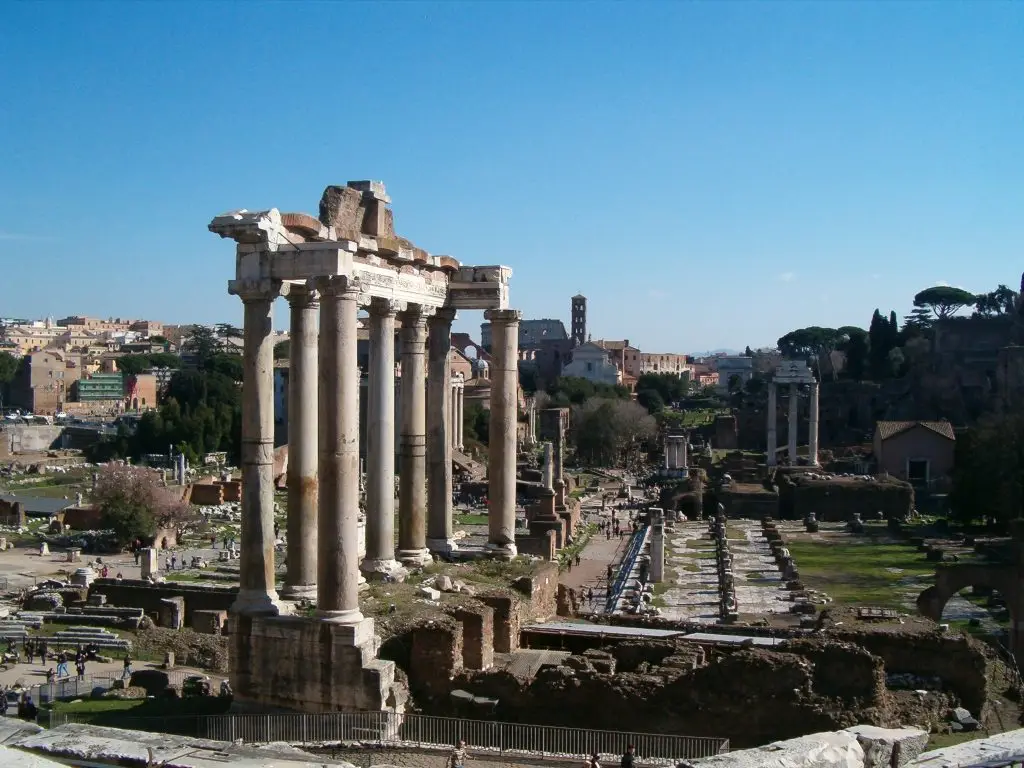
The Temple of Saturn, a religious monument that housed the treasury in ancient Rome
(Wiki Image By Marcok – it.wikipedia.org – Own work, CC BY-SA 3.0, https://commons.wikimedia.org/w/index.php?curid=3705321)
You’re right to focus on bureaucratic inefficiency as a key factor in the Roman Empire’s decline. As the empire grew, its administrative needs expanded, but the bureaucracy often struggled to keep up, becoming bloated and corrupt and ultimately hindering effective governance.
Here’s a table outlining the key aspects of this inefficiency, along with some historical examples:
| Aspect of Bureaucratic Inefficiency | Effects & Challenges | Examples |
| Bloated Bureaucracy | – Excessive growth: The number of officials and administrators grew significantly, creating a complex and unwieldy bureaucracy. <br> – Effects: This led to increased costs, slow decision-making processes, and a lack of accountability. It became increasingly difficult to accomplish tasks, and no one was held accountable when things went wrong. | – By the late Roman Empire, there were countless officials, tax collectors, and administrators throughout the provinces, often with overlapping jurisdictions and conflicting interests. |
| Corruption and Bribery | – Widespread corruption: Corruption became rampant within the bureaucracy, with officials often demanding bribes or favors for services or preferential treatment. <br> – Effects: This created an unfair system where wealth and connections mattered more than justice or merit, undermining the rule of law and eroding public trust. | – Provincial governors demanding bribes from local populations to avoid harsh taxes or punishments. <br> – Senators accepting bribes to influence legislation or legal decisions. |
| Inefficient Administration | – Complex procedures: Administrative procedures became overly complex and time-consuming, hindering effective governance and discouraging people from seeking help or resolving disputes. <br> – Lack of coordination: Poor communication and coordination between different departments and levels of government led to inefficiency and confusion, delaying responses to crises and hindering effective policy implementation. | – The complex tax collection and distribution system involved multiple layers of bureaucracy, often resulting in delays and disputes. <br> – The difficulty in mobilizing resources and troops quickly to respond to emergencies or invasions due to bureaucratic hurdles. |
| Lack of Qualified Officials | – Patronage and nepotism: Positions were often filled based on patronage and personal connections rather than merit, leading to a decline in the quality of officials. <br> – Effects: This resulted in incompetent and ineffective administration, hindering the implementation of policies and the enforcement of laws. | – Emperors appointing unqualified friends or family members to important administrative positions. <br> – Wealthy families use their influence to secure positions for their relatives, regardless of their abilities. |
| Overregulation | – Excessive rules and regulations: The bureaucracy imposed numerous laws and regulations, stifling innovation and economic growth. <br> – Effects: This burdened businesses and individuals, discouraging investment, entrepreneurship, and economic activity. | – Diocletian’s Edict on Maximum Prices (301 AD) attempted to control inflation by setting price ceilings on goods and services, but it largely failed due to its complexity and unenforceability. <br> – The complex trade and commerce regulations hindered economic growth and discouraged innovation. |
Export to Sheets
Overall Impact:
The inefficiency and corruption of the Roman bureaucracy significantly contributed to the empire’s decline. They hindered effective governance, discouraged economic activity, and eroded public trust in the government. This weakened the empire’s ability to respond to financial crises, social unrest, and external threats, ultimately contributing to its downfall.
Fall of the Western Roman Empire. Division of the Empire: The division of the empire into Western and Eastern halves created administrative challenges and weakened its overall strength. Table. Examples.
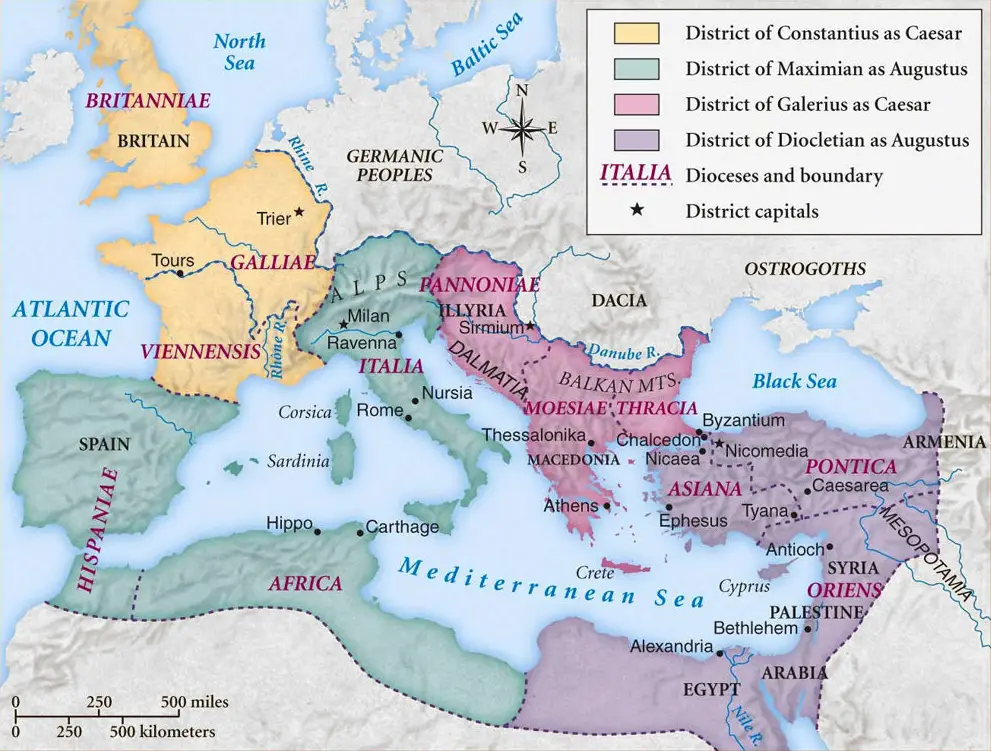
The Roman Empire under the Tetrarchy, showing the dioceses and the four Tetrarchs’ zones of responsibility.
(Wiki Image By Coppermine Photo Gallery – Coppermine Photo Gallery, CC BY-SA 3.0, https://commons.wikimedia.org/w/index.php?curid=4574473)
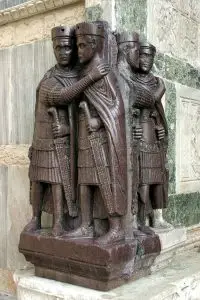
The Tetrarchs, a porphyry statue in Venice‘s Basilica di San Marco, shows the emperor Diocletian and his three imperial colleagues: Diocletian and Maximianus, the two Augusti (co-emperors); Galerius and Constantius Chlorus, the two Caesars (deputy emperors). Note the woolen “Pannonian” caps commonly worn (out of combat) by officers in the late army due to the pervasive influence of the Danubian officer class and the sword grips with eagle-head pommels.
(Wiki Image By Nino Barbieri (talk · contribs) – Own work, Public Domain, https://commons.wikimedia.org/w/index.php?curid=1697833)
You’re right to focus on the division of the Roman Empire as a key factor in its decline! While intended to make the vast empire easier to manage, the split between East and West created new challenges and weakened Rome’s overall strength.
Here’s a table outlining the key aspects of this division, along with some historical examples:
| Aspect of Division | Effects & Challenges | Examples |
| Administrative Split | – Two Capitals: The empire was formally divided into Western and Eastern halves, with capitals in Rome and Constantinople (formerly Byzantium). <br> – Effects: This created two separate administrative centers, leading to difficulties coordinating policies, resources, and military actions. It became harder to present a united front or respond quickly to crises. | – Emperor Diocletian (284-305 AD) initiated the division of the empire for administrative efficiency. <br> – Theodosius I (379-395 AD) made the division permanent, with his sons ruling the Western and Eastern halves. |
| Economic Disparity | – Unequal Resources: The Eastern half (later the Byzantine Empire) was wealthier and more economically stable due to its access to trade routes and resources. <br> – Effects: This created resentment and competition between the two halves, as the Western Empire struggled with economic decline and the Eastern Empire often withheld support. This led to a lack of cooperation and even conflict between the two halves. | – The Eastern Empire controlled key trade routes to the East, including the Silk Road, giving it access to valuable goods and resources. <br> – The Western Empire faced economic challenges, including inflation, declining trade, and barbarian incursions, making it reliant on support from the East, which was often not forthcoming. |
| Military Weakness | – Divided Forces: The Roman legions were split between the two halves, weakening the overall military strength and making it difficult to respond effectively to threats on multiple fronts. <br> – Lack of Coordination: Coordinating military campaigns and defenses between the two halves was challenging, leading to delays and strategic vulnerabilities. | – The Western Roman Empire struggled to defend its borders against barbarian invasions due to a lack of resources and manpower. <br> – The Eastern Roman Empire, while more stable, was also threatened by external enemies, such as the Sassanid Persians. |
| Political Disunity | – Separate Emperors: Each half had its emperor, leading to potential conflicts and power struggles. <br> – Diverging Interests: The two halves developed distinct political and cultural identities, leading to diverging interests and a lack of unity. This made it difficult to address common challenges and weakened the empire’s overall cohesion. | – The emperors of the two halves often had different priorities and policies, leading to disagreements and conflicts. <br> – The Western Roman Empire became increasingly influenced by Germanic culture, while the Eastern Roman Empire retained a more traditional Roman identity. |
| Vulnerability to External Threats | – Weakened Defenses: The divided empire was more vulnerable to external threats, as enemies could exploit the lack of coordination and concentrate their forces on one half at a time. <br> – Example: The Visigoths sacked Rome in 410 AD, while the Eastern Empire remained relatively secure. This highlighted the vulnerability of the Western Empire and its inability to defend itself effectively. | – The Huns, under Attila, invaded both halves of the empire in the 5th century AD, but the Eastern Empire was better able to withstand their attacks. |
Export to Sheets
Overall Impact:
While the division of the Roman Empire was intended to improve administration, it ultimately created a range of challenges that weakened its overall strength and contributed to its decline. Administrative difficulties, economic disparity, military weakness, and political disunity made the empire more vulnerable to internal strife and external threats. The Western Roman Empire, in particular, suffered from these challenges and eventually collapsed in 476 AD, while the Eastern Roman Empire (Byzantine Empire) continued for another thousand years.
Fall of the Western Roman Empire. Corruption and Greed: Corruption within the government and ruling class diverted resources and weakened the empire’s administration. Table. Examples.
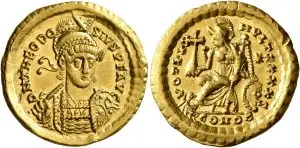
Ancient Roman solidus depicting Theodosius II
(Wiki Image By Byzantium565 – Own work, CC BY-SA 4.0, https://commons.wikimedia.org/w/index.php?curid=112623565)
You’re right. Corruption and greed were like termites eating away at the foundations of the Roman Empire! When those in power are more interested in lining their pockets than serving the public, it can lead to problems that weaken a society.
Here’s a table summarizing the key aspects of this corruption, along with some historical examples:
| Aspects of Corruption & Greed | Effects & Challenges | Examples |
| Bribery and Extortion | – Prevalence of bribery: Officials at various levels of government often demanded bribes or favors in exchange for services or preferential treatment. <br> – Effects: This created an unfair system where wealth and connections mattered more than justice or merit, undermining the rule of law. | – Provincial governors in distant parts of the empire demanding bribes from local populations to avoid harsh taxes or punishments. <br> – Senators accepting bribes to influence legislation or legal decisions in favor of wealthy individuals or groups. |
| Embezzlement and Misappropriation of Funds | – Theft of public funds: Government officials and ruling class members often embezzled public funds for personal gain. <br> – Effects: This diverted resources from essential services, such as infrastructure maintenance, military spending, and public works, weakening the empire’s ability to function effectively. | – Officials in charge of public works projects, like road construction or aqueduct maintenance, skimming funds for themselves, leading to shoddy work and eventual decay. <br> – Tax collectors pocketed some of their collected taxes, depriving the government of much-needed revenue. |
| Nepotism and Favoritism | – Unqualified appointments: Positions of power were often given to friends and family members, regardless of their qualifications or competence. <br> – Effects: This led to inefficient administration, poor decision-making, and declining leadership quality. | – Emperors appointed family members or close friends to important military or administrative positions, even if they lacked the necessary skills or experience. <br> – Wealthy families use their influence to secure positions for their relatives in the government or military, regardless of their abilities. |
| Lavish Spending and Extravagance | – Wasteful expenditures: Emperors and the ruling class often spent lavishly on personal luxuries, entertainment, and grandiose projects. <br> – Effects: This drained the empire’s finances and diverted resources from more essential needs, such as maintaining the military and supporting the poor. | – Construction of extravagant palaces and villas for the emperor and the wealthy elite, consuming vast amounts of resources and labor. <br> – Hosting lavish banquets and games for the elite’s entertainment while the ordinary people struggled with poverty and food shortages. |
| Decline in Public Trust | – Erosion of confidence: The widespread corruption and greed within the government and ruling class eroded public trust and confidence in the system. <br> – Effects: This led to social unrest, tax evasion, and a decline in civic participation, further weakening the empire’s ability to function effectively. | – Citizens becoming disillusioned with the government’s ability to provide justice and stability. <br> – Increased reliance on private armies and patronage networks for protection and advancement, as people lost faith in the government’s ability to provide these services. |
Export to Sheets
Overall Impact:
The pervasive corruption and greed within the Roman Empire significantly impacted its decline. They weakened the administration, diverted resources, and eroded public trust, making the empire more vulnerable to internal strife and external threats.
Fall of the Western Roman Empire. Loss of Senatorial Power: The Senate, once a powerful governing body, lost influence and authority, leading to a decline in effective governance. Table. Examples.
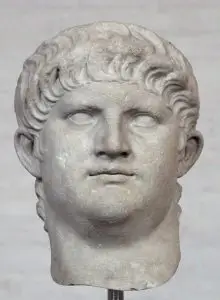
Nero Claudius Caesar Augustus Germanicus (/ˈnɪəroʊ/ NEER-oh; born Lucius Domitius Ahenobarbus; 15 December AD 37 – 9 June AD 68) was a Roman emperor and the final emperor of the Julio-Claudian dynasty, reigning from AD 54 until he died in AD 68.
(Wiki Image By User:Bibi Saint-Pol, own work, 2007-02-08, Public Domain, https://commons.wikimedia.org/w/index.php?curid=1814923)
You’re spot on in highlighting the decline of the Roman Senate as a key factor in the Empire’s fall! The Senate, a powerful body in the Republic, gradually lost its teeth under the emperors. This power shift greatly impacted how Rome was governed (or misgoverned, as it were).
Here’s a table breaking down the key aspects of this decline, with some historical examples to illustrate:
| Aspect of Decline | Effects & Challenges | Examples |
| Erosion of Authority | – Rise of the Emperors: As the Roman Republic transitioned into the Roman Empire, emperors consolidated power and increasingly bypassed the Senate in decision-making. <br> – Effects: This diminished the Senate’s role in governance and reduced its ability to check the emperor’s power, leading to more autocratic rule. | – Augustus, the first Roman Emperor, cleverly maintained the appearance of respecting the Senate, but in reality, he held most of the power. <br> – Later emperors, like Caligula and Nero, were far less subtle, openly ignoring or even humiliating the Senate. |
| Loss of Independence | – Imperial Appointments: Emperors began to appoint senators directly, rather than relying on elections, undermining the Senate’s independence and making it more susceptible to imperial influence. <br> – Effects: This reduced the Senate’s ability to represent the people’s interests and counterbalance to the emperor’s authority. It became a rubber-stamp institution. | – Emperors used their power to appoint loyalists and supporters to the Senate, ensuring its compliance with their wishes and reducing its ability to oppose them. |
| Decline in Competence | – Shifting Focus: As the Senate’s power diminished, many talented and ambitious individuals sought military or imperial administration careers, leaving the Senate with fewer capable members. <br> – Effects: This led to a decline in the quality of debate and decision-making within the Senate, hindering its ability to address the empire’s challenges effectively. | – The Senate became increasingly filled with individuals who were more concerned with personal gain and social status than serving the public good. This led to ineffective policies and a lack of decisive action. |
| Corruption and Intimidation | – Corruption: Corruption became rampant within the Senate, with senators often accepting bribes or favors in exchange for their votes or influence. <br> – Intimidation: Emperors frequently used intimidation tactics to suppress dissent and ensure the Senate’s compliance with their wishes. <br> – Effects: This further eroded the Senate’s credibility and undermined its ability to act as a check on imperial power. | – Emperors like Tiberius and Domitian used informers and secret police to monitor and control the Senate, creating a climate of fear and mistrust. This discouraged senators from speaking out against the emperor or proposing alternative policies. |
| Loss of Public Trust | – Decline in Prestige: As the Senate became increasingly associated with corruption and inefficiency, it lost the respect and trust of the Roman people. <br> – Effects: This weakened the government’s legitimacy and contributed to social unrest and a decline in civic participation. | – The Roman people increasingly viewed the Senate as a symbol of the empire’s decline and inability to address their concerns. This led to a loss of faith in the government and a decline in civic engagement. |
Export to Sheets
Overall Impact:
The decline of the Roman Senate’s power and influence significantly impacted the empire’s decline. It weakened the system of checks and balances, reduced the effectiveness of governance, and contributed to a loss of public trust in the government. This made the empire more vulnerable to internal strife and external threats, ultimately playing a role in its eventual collapse.
Fall of the Western Roman Empire. Military Interference in Politics: The military increasingly interfered in politics, leading to instability and civil wars. Table. Examples.
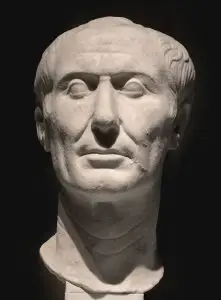
Gaius Julius Caesar (12 July 100 BC – 15 March 44 BC) was a Roman general and statesman. A member of the First Triumvirate, Caesar led the Roman armies in the Gallic Wars before defeating his political rival Pompey in a civil war. Subsequently, he became dictator from 49 BC until his assassination in 44 BC.
(Wiki Image By Ángel M. Felicísimo from Mérida, España – Retrato de Julio César, Public Domain, https://commons.wikimedia.org/w/index.php?curid=91281949)
You’re focusing on a crucial factor that contributed to the fall of the Roman Empire: military interference in politics! As the Roman legions gained power and influence, they increasingly intervened in political affairs, leading to instability, civil wars, and weakening the empire’s governance. Here’s a table breaking down this issue:
| Aspect of Military Interference | Effects & Challenges | Examples |
| Rise of Military Power | – Powerful Generals: Successful generals gained immense popularity and influence, often using their legions to exert political pressure or seize power for themselves. <br> – Effects: This undermined the authority of the Senate and the emperors, leading to political instability and frequent power struggles. | – Julius Caesar’s rise to power through military conquest and his eventual dictatorship. <br> – The Praetorian Guard, the emperor’s bodyguard, often played a kingmaker role, influencing the selection of emperors and sometimes assassinating them. |
| Civil Wars | – Military Backing: Ambitious generals often used their loyal legions to launch bids for power, leading to devastating civil wars. <br> – Effects: These conflicts drained resources, weakened the empire’s defenses, and caused widespread instability and suffering. | – Caesar’s Civil War (49-45 BC) between Julius Caesar and Pompey the Great. <br> – The Year of the Four Emperors (69 AD), an intense civil war with multiple claimants to the throne. <br> – The Crisis of the Third Century (235-284 AD), a period of near-constant civil war and political upheaval fueled by military intervention. |
| Weakening of Civilian Institutions | – Decline of the Senate: As military leaders gained influence, the Senate’s power and authority diminished, weakening the traditional system of governance. <br> – Effects: This led to a more autocratic and less accountable form of government, as emperors increasingly relied on military support to maintain power. | – The Senate gradually lost power under the emperors, particularly during the Dominate period (284 AD onwards). |
| Military Emperors | – Soldier-Emperors: Many emperors in the later Roman Empire rose to power through military ranks, often lacking the experience or skills for effective governance. <br> – Effects: This usually led to short reigns, political instability, and a focus on military concerns over civilian needs. | – The “barracks emperors” of the 3rd century AD were often proclaimed emperor by their troops and had short, unstable reigns. |
| Barbarian Incursions | – Weakened Defenses: The constant civil wars and political instability weakened the empire’s defenses, making it more vulnerable to incursions by barbarian tribes. <br> – Effects: These incursions further destabilized the empire and eventually collapsed. | – The sack of Rome by the Visigoths in 410 AD. <br> – The eventual fall of the Western Roman Empire in 476 AD to the Germanic chieftain Odoacer. |
Export to Sheets
Overall Impact:
The increasing military interference in Roman politics significantly impacted the empire’s decline. It led to political instability, civil wars, weakening civilian institutions, and vulnerability to external threats.
Economic and Social Factors
Fall of the Western Roman Empire. Economic Decline: Inflation, high taxes, and a decline in trade weakened the economy and created social unrest. Table. Examples.
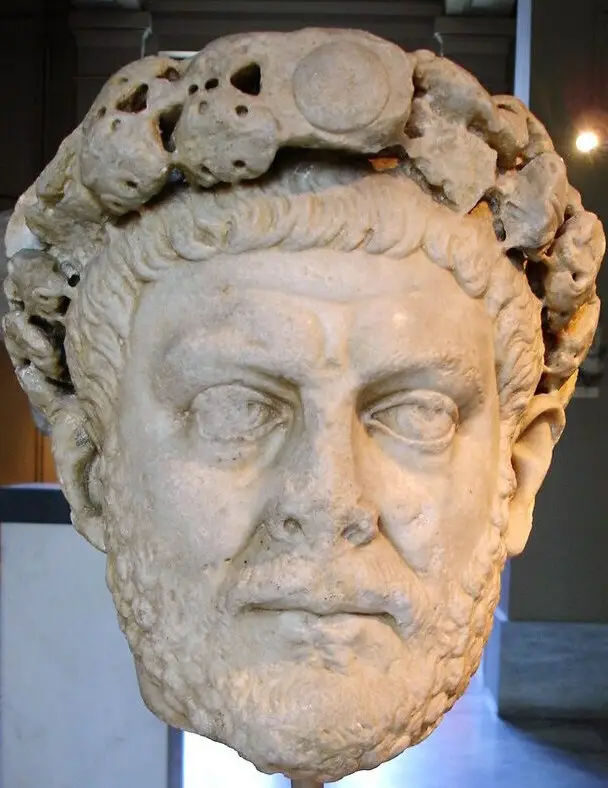
Likely head of Diocletian, wearing a corona civica
(Wiki image Attribution, https://commons.wikimedia.org/w/index.php?curid=26323391)
You’re focusing on a significant internal factor that contributed to the decline of the Roman Empire: economic decline! Here’s a table outlining how inflation, high taxes, and a decline in trade weakened the Roman economy and fueled social unrest:
| Aspect of Economic Decline | Effects & Challenges | Examples |
| Inflation | – Rising Prices: The Roman Empire experienced significant inflation, where the currency’s value decreased, and the prices of goods and services rose dramatically. <br> – Effects: This eroded the purchasing power of people’s savings, made it difficult to afford necessities, and created economic instability. | – The Roman government debased its currency by reducing the amount of precious metal in coins, leading to inflation. <br> – Diocletian’s Edict on Maximum Prices (301 AD) attempted to control inflation by setting price ceilings, but it largely failed. |
| High Taxation | – Oppressive Taxes: The Roman government imposed heavy taxes on its citizens and provinces to fund its vast military and bureaucracy. <br> – Effects: This burdened individuals and businesses, discouraged investment and economic growth, and fueled resentment towards the government. | – Land taxes, property taxes, and taxes on trade goods were ordinary in the Roman Empire. <br> – Tax burdens increased in the later empire as the government struggled to maintain its finances. |
| Decline in Trade | – Disrupted Trade Routes: Invasions, piracy, and political instability disrupted trade routes, reducing the flow of goods and impacting the economy. <br> – Effects: This led to shortages of essential goods, increased prices, and decreased economic activity. | – Barbarian invasions disrupted trade routes across the empire. <br> – Piracy in the Mediterranean Sea hindered maritime trade. |
| Loss of Resources | – Depletion of Resources: The Roman Empire’s extensive military campaigns and lavish spending depleted its resources, including precious metals and manpower. <br> – Effects: This contributed to economic decline and made maintaining infrastructure and public services difficult. | – The cost of maintaining a large standing army and expanding the empire’s borders drained its resources. <br> – The construction of extravagant buildings and public works projects also consumed significant resources. |
| Social Unrest | – Poverty and Inequality: Economic decline increased poverty and social inequality, creating tensions between the rich and the poor. <br> – Effects: This fueled social unrest, riots, and rebellions, further destabilizing the empire and hindering its ability to address its economic challenges. | – The Bacaudae, a peasant revolt in Gaul in the 3rd century AD, was partly fueled by economic hardship and social inequality. <br> – Urban riots and protests became more frequent in the later empire as economic conditions worsened. |
Export to Sheets
Overall Impact:
The Roman Empire’s economic decline profoundly impacted its stability and longevity. Inflation, high taxes, and a decline in trade created economic hardship, social unrest, and a weakening government’s ability to address these challenges. This contributed to a downward spiral that ultimately played a significant role in the empire’s collapse.
Fall of the Western Roman Empire. Overreliance on Slave Labor: The reliance on slave labor discouraged technological innovation and created economic imbalances. Table. Examples.
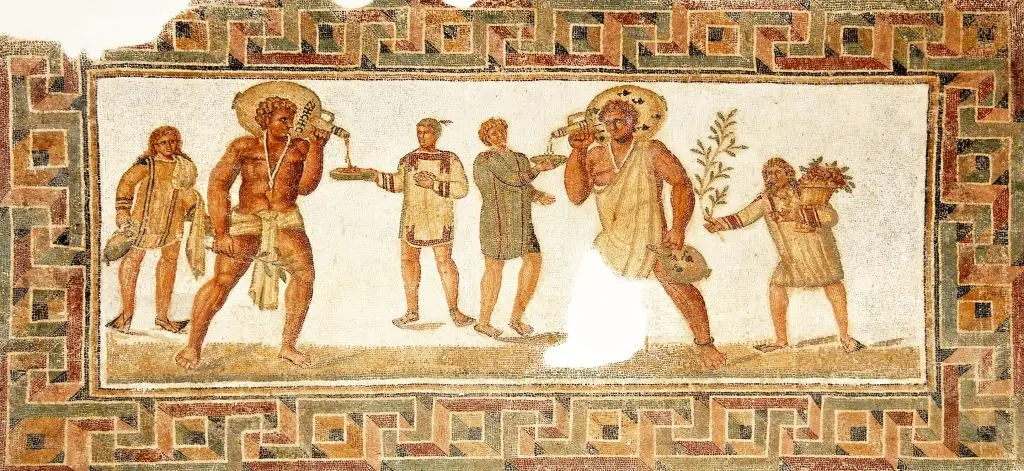
Roman mosaic from Dougga, Tunisia (2nd/3rd century AD): two large slaves carrying wine jars each wears an amulet against the evil eye on a necklace, with one in a loincloth (left) and the other in an exomis; the young slave to the left carries water and towels, and the one on the right a bough and a basket of flowers.
(Wiki Image By Dennis G. Jarvis – Flickr: Tunisia-4718 – A Banquet, CC BY-SA 2.0, https://commons.wikimedia.org/w/index.php?curid=22436409)
You’re focusing on a key factor in the decline of the Roman Empire: the overreliance on slave labor! While slavery was a common practice in the ancient world, Rome’s dependence on it had significant negative consequences for its economy and society. Here’s a table outlining the problems:
| Aspect of Overreliance | Effects & Challenges | Examples |
| Lack of Technological Innovation | – Disincentive to innovate: The availability of cheap slave labor discouraged the development of labor-saving technologies and innovations. <br> – Effects: This limited productivity growth and hindered economic development in the long term. | – While the Romans made significant advancements in engineering and architecture, they lagged in developing new technologies like agriculture and manufacturing. |
| Economic Imbalances | – Wealth concentration: Slavery contributed to the concentration of wealth in the hands of a few, as wealthy landowners and elites profited from the labor of enslaved people. <br> – Effects: This created a large gap between the rich and the poor, leading to social unrest and economic instability. | – Large estates (latifundia) relied heavily on slave labor, displacing free farmers and contributing to economic inequality. |
| Dependence and Vulnerability | – Dependence on slave imports: The Roman economy depended on a constant influx of slaves acquired through conquest and trade. <br> – Effects: When expansion slowed or trade routes were disrupted, the supply of slaves dwindled, leading to labor shortages and economic disruption. | – The decline in Roman military expansion in the 2nd century AD led to a decrease in the supply of slaves. |
| Moral and Social Consequences | – Dehumanization: The institution of slavery dehumanized both the enslaved people and the slave owners, contributing to a decline in moral values and social cohesion. <br> – Effects: This created a society where violence and exploitation were normalized, potentially undermining civic virtue and contributing to social unrest. | – Slave revolts, such as the Spartacus uprising (73-71 BC), highlighted the tensions and injustices inherent in the system. |
| Limited Economic Mobility | – Competition with free labor: The availability of slave labor limited opportunities for free laborers and artisans, contributing to unemployment and social unrest. <br> – Effects: This stifled economic mobility and made discontented citizens more susceptible to political extremism and social upheaval. | – Free laborers often struggled to compete with the low cost of slave labor, leading to economic hardship and resentment. |
Export to Sheets
Overall Impact:
The Roman Empire’s overreliance on slave labor had significant negative consequences for its economy and society. It discouraged technological innovation, created economic imbalances, and contributed to social unrest and moral decline. While slavery provided short-term benefits for the elite, it ultimately hindered the empire’s long-term development and contributed to its eventual downfall.
Fall of the Western Roman Empire. Social Inequality: The gap between the rich and the poor widened, leading to social tensions and unrest. Table. Examples.
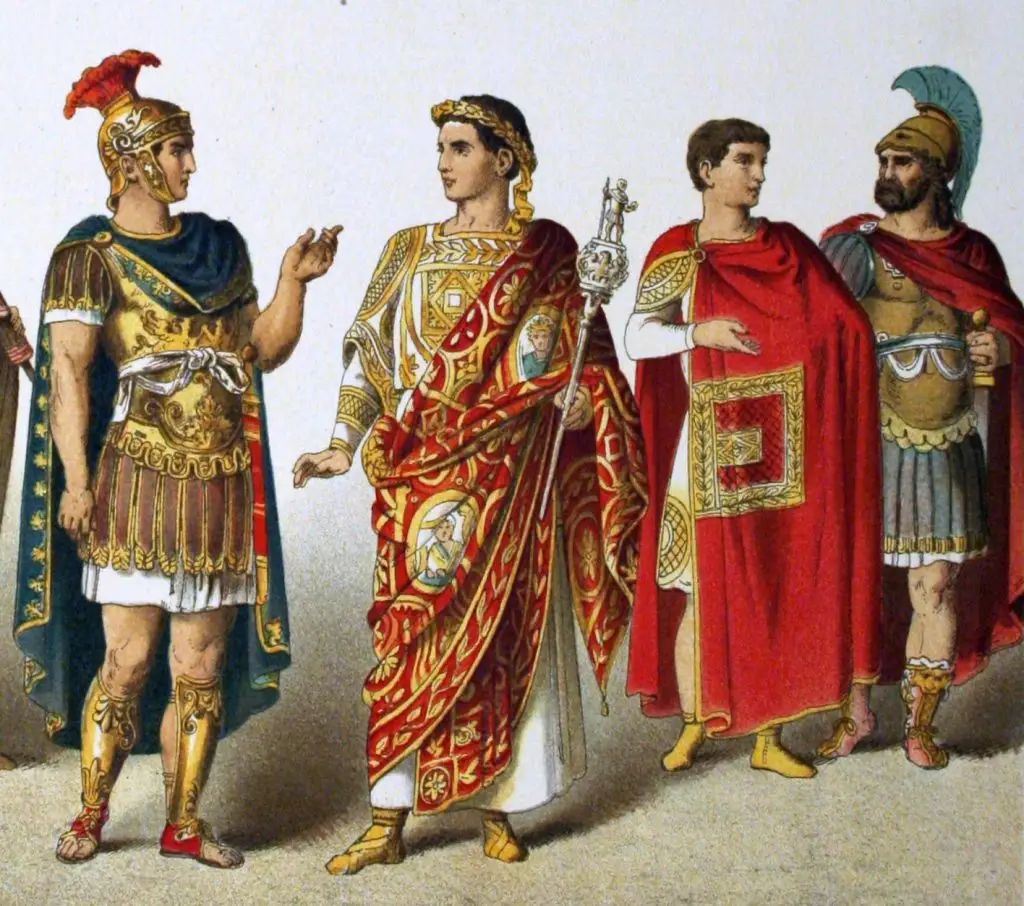
Example of higher-class Roman men
(Wiki Image by Albert Kretschmer, a painter and customer at the Royal Court Theatre, Berlin, and Dr. Carl Rohrbach. – Costumes of All Nations (1882), Public Domain, https://commons.wikimedia.org/w/index.php?curid=73285690)
You’re focusing on a crucial factor that contributed to the decline of the Roman Empire: social inequality! The widening gap between the rich and the poor created significant social tensions and unrest, weakening the empire. Here’s a table breaking down the issue:
| Aspect of Social Inequality | Effects & Challenges | Examples |
| Wealth Concentration | – Growing Gap: The wealth of the Roman Empire became increasingly concentrated in the hands of a small elite while most of the population struggled with poverty. <br> – Effects: This created resentment and social unrest, as the poor felt increasingly marginalized and exploited. | – Large estates (latifundia) owned by wealthy landowners, worked by slaves and tenant farmers. <br> – Lavish lifestyles of the Roman elite, contrasting with the poverty of the urban masses. |
| Limited Social Mobility | – Rigid Class Structure: The Roman social structure was rigid, making it difficult for individuals to move up in society. <br> – Effects: This created a sense of hopelessness and frustration among the lower classes, who saw little opportunity for advancement. | – The difficulties faced by freedmen (former slaves) in achieving full citizenship and social acceptance. <br> – The limited opportunities for the urban poor to improve their economic and social status. |
| Exploitation of the Poor | – Cheap Labor: The poor were often exploited for their labor, working in harsh conditions for low wages. <br> – Effects: This created resentment and fueled social unrest, as the poor felt increasingly marginalized and exploited. | – The use of slave labor in agriculture and other industries. <br> – The exploitation of the urban poor by wealthy landowners and merchants. |
| Political Corruption | – Influence of the Wealthy: The wealthy elite used their influence to control the political system and protect their interests. <br> – Effects: This led to corruption and a lack of representation for the lower classes, further exacerbating social inequality. | – The practice of bribery and patronage in Roman politics. <br> – The Senate is increasingly dominated by the wealthy elite. |
| Social Unrest and Conflict | – Riots and Rebellions: The growing social inequality and economic hardship fueled social unrest, leading to riots, protests, and even rebellions. <br> – Effects: This destabilized the empire and weakened its ability to address its internal and external challenges. | – The bread and circuses policy was used to appease the urban masses with free food and entertainment. <br> – The rise of popular leaders who exploited social discontent for political gain. |
Export to Sheets
Overall Impact:
The widening gap between the rich and the poor in the Roman Empire significantly impacted its decline. Social inequality created tensions, fueled unrest, and weakened the empire’s social fabric. This contributed to a climate of instability and resentment, making the empire more vulnerable to internal strife and external threats.
Fall of the Western Roman Empire: A Decline in Civic Virtue: A decline in civic responsibility and participation weakened the empire’s social fabric. Table. Examples.
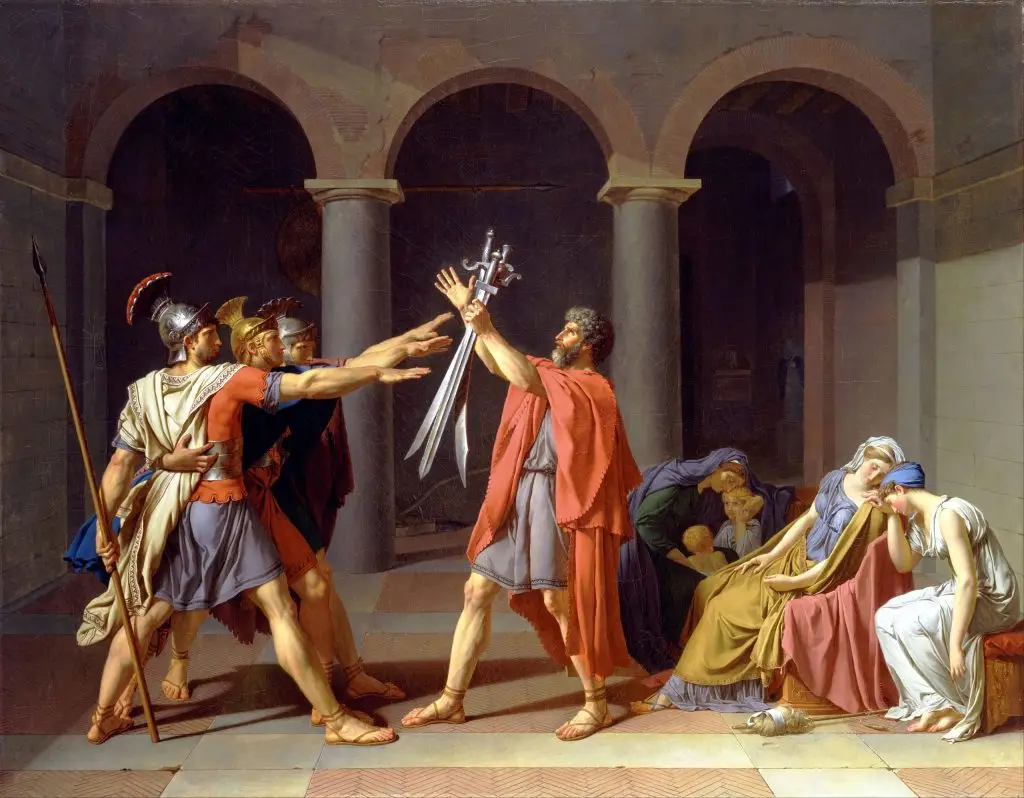
Jacques-Louis David‘s 1786 painting The Oath of the Horatii illustrates a dramatic moment from Livy‘s history of Rome and embodies 18th-century ideas about civic virtue.
(Wiki image By Anne-Louis Girodet de Roussy-Trioson/ Jacques-Louis David – KwHkqyZxc2i04A at Google Cultural Institute maximum zoom level, Public Domain, https://commons.wikimedia.org/w/index.php?curid=21977949)
You’re right to focus on the decline of civic virtue as a key factor in the fall of the Roman Empire! It’s a complex issue that affected many aspects of Roman society. Here’s a table outlining the key elements of this decline and its impact:
| Aspect of Decline in Civic Virtue | Effects & Challenges | Examples |
| Decreased Public Service | – Loss of Motivation: Citizens became less willing to participate in public service, such as serving in the military or holding public office. <br> – Effects: This led to a shortage of qualified individuals in government and the military, weakening the empire’s administration and defense. | – Difficulty recruiting soldiers for the legions, increasing reliance on foreign mercenaries. <br> – Decline in the prestige of public office, with fewer citizens willing to serve in the Senate or other government positions. |
| Erosion of Traditional Values | – Shifting Values: Traditional Roman values, such as patriotism, discipline, self-sacrifice, and civic duty, declined in importance. <br> – Effects: This weakened the social fabric of the empire and eroded the sense of shared responsibility for the common good. | – Increased emphasis on personal wealth and luxury, leading to a decline in public spirit. <br> – Growing popularity of “bread and circuses” entertainment, distracting citizens from political and social issues. |
| Apathy and Disengagement | – Political Apathy: Citizens became less interested in participating in the political process and less concerned about the empire’s well-being. <br> – Effects: This allowed corruption and ineffective leadership to flourish, further weakening the government’s ability to address the empire’s challenges. | – Low voter turnout in elections and a decline in public discourse on important issues. <br> – Increased reliance on the emperor and the bureaucracy to solve problems rather than active citizen participation. |
| Decline in Public Morality | – Moral Decay: Some historians argue that there was a decline in public morality, with increased corruption, crime, and social disorder. <br> – Effects: This eroded trust in institutions and weakened the social fabric of the empire. | – Increase in crime rates in Roman cities. <br> – Spread of gladiatorial games and other violent forms of entertainment, potentially desensitizing the population to violence. |
| Loss of Common Identity | – Fragmentation: The vast size and diversity of the Roman Empire made it difficult to maintain a sense of shared identity and common purpose. <br> – Effects: This contributed to social divisions and decreased civic participation, as people felt less connected to the empire. | – Growing regional differences and tensions within the empire. <br> – The rise of new religions and philosophies that challenged traditional Roman values and beliefs. |
Export to Sheets
Overall Impact:
The decline in civic virtue profoundly impacted the decline of the Roman Empire. It weakened the government, eroded social cohesion, and made the empire vulnerable to internal and external threats.
Fall of the Western Roman Empire. Loss of Patriotism: Citizens became less invested in the empire’s well-being, leading to decreased military recruitment and civic engagement. Table. Examples.
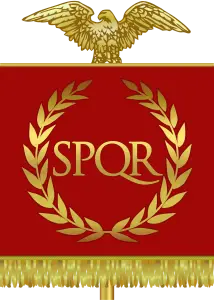
Vexillum and aquila displaying SPQR (Senatus Populusque Romanus)
(Wiki Image By Ssolbergj – The vexillum of the Roman Empire was a red banner with the letters SPQR in Gold surrounded by a gold wreath hung on a military standard topped by a Roman eagle or an image of the goddess Victoria made of silver or bronze.[1][2][3][4], CC BY 3.0, https://commons.wikimedia.org/w/index.php?curid=4249122)
You’re focusing on a crucial internal factor that contributed to the decline of the Roman Empire: loss of patriotism! As citizens became less invested in the empire’s well-being, it led to a decline in civic engagement and military recruitment, weakening the empire from within. Here’s a table breaking down this issue:
| Aspect of Decline in Patriotism | Effects & Challenges | Examples |
| Decline in Civic Engagement | – Reduced Participation: Citizens became less involved in public life and less willing to participate in civic duties, such as voting, serving in local government, or contributing to public works. <br> – Effects: This led to a decline in the quality of leadership and a weakening of community bonds, making it harder to address social and economic problems. | – Decreased voter turnout in elections. <br> – Difficulty in finding qualified individuals to fill public offices. <br> – Decline in voluntary contributions to public projects. |
| Decreased Military Recruitment | – Difficulty Filling Ranks: The Roman legions, once a source of pride and patriotism, struggled to attract recruits as citizens became less willing to serve in the military. <br> – Effects: This led to a decline in the quality and size of the army, making the empire more vulnerable to external threats. | – Increased reliance on foreign mercenaries and conscripted soldiers, who often lacked the loyalty and discipline of Roman citizens. <br> – Decline in military training and preparedness, weakening the effectiveness of the legions. |
| Erosion of Shared Identity | – Loss of Common Purpose: The vast size and diversity of the Roman Empire made it difficult to maintain a sense of shared identity and common purpose among its citizens. <br> – Effects: This contributed to decreased patriotism and civic engagement, as people felt less connected to the empire. | – Growing regional differences and tensions within the empire. <br> – The rise of new religions and philosophies that challenged traditional Roman values and beliefs. |
| Focus on Personal Gain | – Materialism and Self-Interest: As the empire prospered, many citizens became more focused on personal wealth and comfort, with less emphasis on civic duty and the common good. <br> – Effects: This contributed to a decline in public spirit and weakened the social fabric as people became less willing to sacrifice for the empire. | – The rise of a wealthy elite who lived in luxury and extravagance, contrasting with the poverty of many ordinary citizens. <br> – The popularity of “bread and circuses” entertainment distracted people from political and social issues. |
| Loss of Faith in the Government | – Corruption and Inefficiency: The growing corruption and inefficiency of the Roman government, particularly in the later empire, led to a loss of faith in its ability to protect and provide for its citizens. <br> – Effects: This contributed to decreased patriotism and civic engagement, as people felt less obligated to support a government they perceived as ineffective or corrupt. | – Frequent changes in leadership and political instability. <br> – High taxes and economic hardship fueled resentment towards the government. |
Export to Sheets
Overall Impact:
The decline in patriotism within the Roman Empire significantly impacted its decline. It weakened the military, eroded social cohesion, and made the empire vulnerable to internal strife and external threats.
Fall of the Western Roman Empire: Urban Decay: Major cities experienced overcrowding, poverty, and declining infrastructure. Table. Examples.
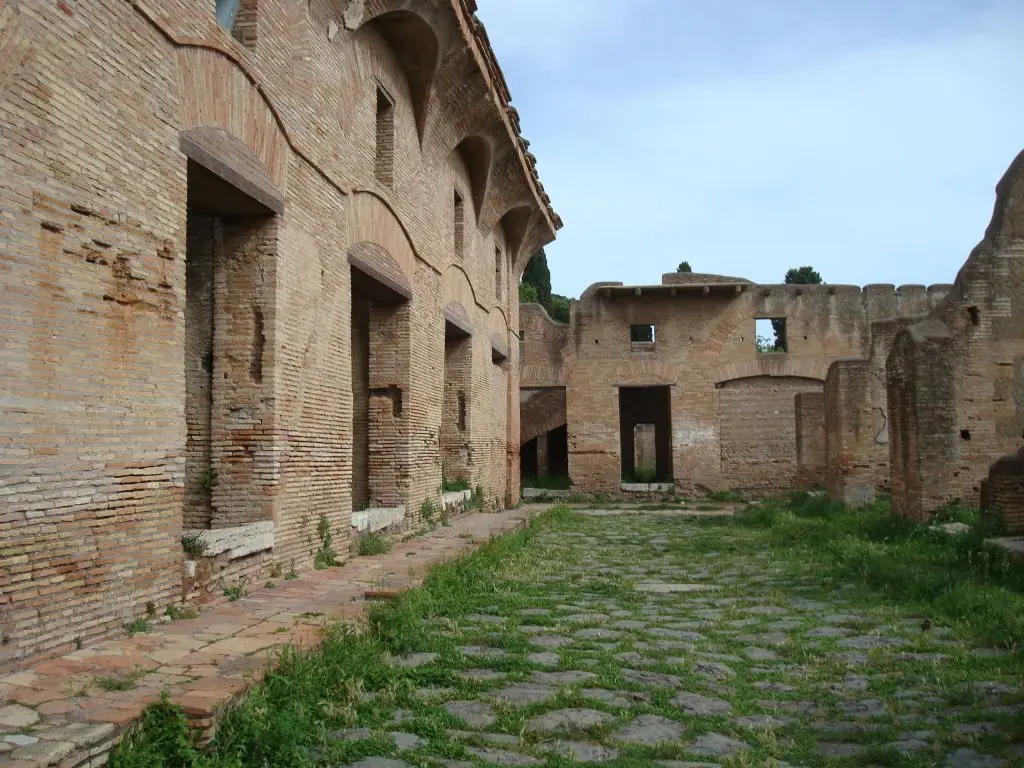
Plebeians in ancient Rome lived in three- or four-story buildings called an insula, which were apartment buildings that housed many families. These apartments usually lacked running water and heat. These buildings had no bathrooms, and it was common for a pot to be used.
(Wiki Image By I, Charles Gardner took this photograph – Self-photographed, Public Domain, https://commons.wikimedia.org/w/index.php?curid=4296433)
You’re focusing on a significant aspect of the Roman Empire’s decline: urban decay! As the empire faced various challenges, its significant cities experienced overcrowding, poverty, and a decline in infrastructure, contributing to social unrest and instability. Here’s a table breaking down this issue:
| Aspect of Urban Decay | Effects & Challenges | Examples |
| Overcrowding | – Population Density: Roman cities, especially Rome, became increasingly overcrowded as people migrated from rural areas seeking opportunities or fleeing instability. <br> – Effects: This led to cramped living conditions, sanitation problems, and increased risk of disease outbreaks. | – Rome’s population reached an estimated 1 million people at its peak, leading to significant overcrowding and resource strain. <br> – Insulae (multi-story apartment buildings) often housed many families in cramped and unsanitary conditions. |
| Poverty and Unemployment | – Economic Hardship: Economic decline and the concentration of land ownership in the hands of the wealthy led to widespread poverty and unemployment in urban areas. <br> – Effects: This created a large underclass of impoverished citizens susceptible to social unrest and political manipulation. | – The reliance on slave labor limited opportunities for free laborers and contributed to unemployment. <br> – The “bread and circuses” policy, providing free food and entertainment, appeased the urban poor and distracted them from their hardships. |
| Infrastructure Decline | – Neglect of Maintenance: The Roman government’s financial difficulties and focus on military spending led to a neglect of infrastructure maintenance in many cities. <br> – Effects: This resulted in deteriorating roads, bridges, aqueducts, and public buildings, impacting sanitation, transportation, and the overall quality of life. | – Many Roman roads and aqueducts fell into disrepair, hindering trade and access to clean water. <br> – Public buildings, such as bathhouses and temples, were often neglected and ruined. |
| Crime and Social Disorder | – Increased Crime: Poverty, unemployment, and overcrowding contributed to increased crime and social disorder in Roman cities. <br> – Effects: This created a sense of insecurity and lawlessness, undermining public trust in the government and further contributing to social unrest. | – Theft, robbery, and violence became more common in urban areas. <br> – The rise of gangs and criminal organizations that exploited the vulnerable and contributed to social instability. |
| Public Health Issues | – Sanitation Problems: Overcrowding and inadequate sanitation led to the spread of diseases and epidemics. <br> – Effects: This impacted public health and contributed to a decline in the population, further weakening the empire’s workforce and tax base. | – Outbreaks of diseases like the Antonine Plague and the Plague of Cyprian decimated the population of Roman cities. <br> – Limited access to clean water and proper sewage disposal contributed to the spread of disease. |
Export to Sheets
Overall Impact:
Urban decay significantly impacted the Roman Empire’s decline. Overcrowding, poverty, infrastructure decline, and social disorder weakened the empire’s social fabric, fueled unrest, and hindered its ability to address its challenges. This led to a downward spiral that ultimately collapsed the empire.
Fall of the Western Roman Empire. Agrarian Crisis: Land ownership became concentrated in the hands of a few wealthy individuals, leading to rural poverty and a decline in agricultural production. Table. Examples.
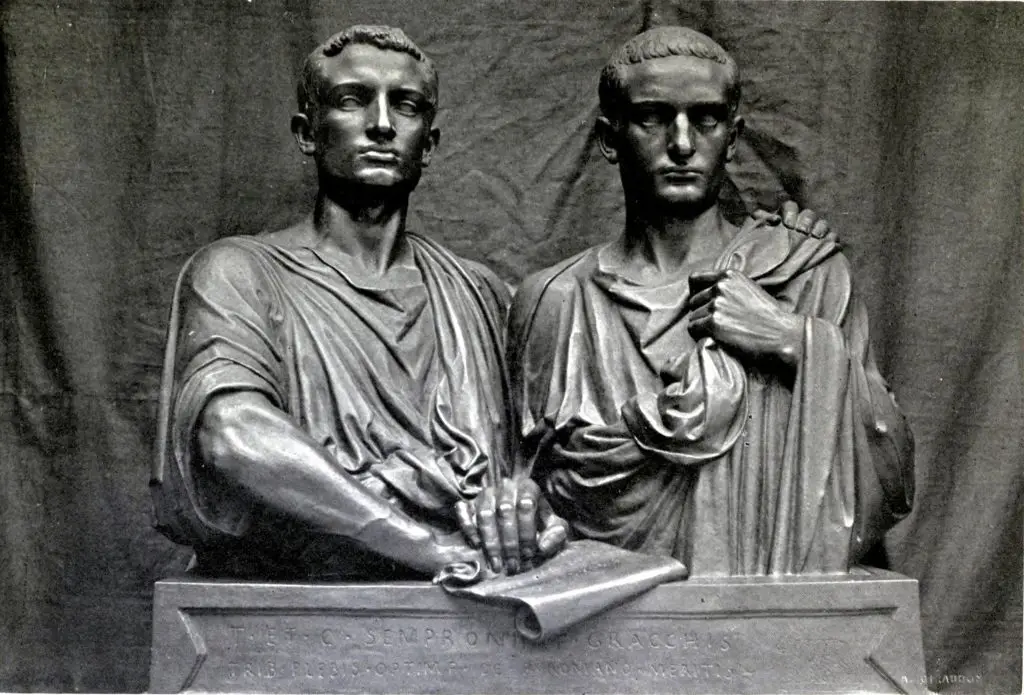
The Gracchi brothers, Tiberius Gracchus and Gaius Gracchus, lived at the beginning of the late Roman Republic. They served in the plebeian tribunates of 133 BC and 122–121 BC, respectively.
(Wiki Image By Jean-Baptiste Claude Eugène Guillaume – https://archive.org/stream/appreciationofsc00sturuoft#page/146/mode/2up, Public Domain, https://commons.wikimedia.org/w/index.php?curid=9173013)
You’re focusing on a crucial factor that contributed to the decline of the Roman Empire: the agrarian crisis! The concentration of land ownership in the hands of a few wealthy individuals led to rural poverty, a decline in agricultural production, and social unrest, ultimately weakening the empire. Here’s a table breaking down this issue:
| Aspect of the Agrarian Crisis | Effects & Challenges | Examples |
| Land Concentration | – Latifundia: Large estates (latifundia) owned by wealthy elites expanded, often absorbing smaller farms and displacing independent farmers. <br> – Effects: This led to a concentration of land ownership and a decline in small farmers, who were the backbone of Roman agriculture and society. | – The Gracchi brothers, Tiberius and Gaius, attempted land reforms in the 2nd century BC to address the issue of land concentration, but their efforts were met with resistance and violence. |
| Decline in Agricultural Production | – Labor Shortages: The reliance on slave labor in latifundia often led to inefficient farming practices and a decline in agricultural productivity. <br> – Soil Exhaustion: Intensive farming practices and deforestation led to soil exhaustion and decreased crop yields. <br> – Effects: This resulted in food shortages, rising prices, and economic hardship, particularly for the urban poor who relied on grain imports. | – The Roman government implemented grain dole programs to provide subsidized food to the urban poor, but this became increasingly unsustainable as agricultural production declined. |
| Rural Poverty and Displacement | – Impoverished Farmers: Small farmers, unable to compete with the large estates, were often forced to sell their land and become tenant farmers or move to cities to seek work. <br> – Effects: This led to widespread rural poverty and increased social tensions between the wealthy landowners and the landless poor. | – The rise of the “colonate” system, where tenant farmers were tied to the land and owed labor and rent to the landowners. |
| Social Unrest and Migration | – Rural Exodus: The decline in agricultural opportunities and the harsh conditions in the countryside led to a mass migration of people from rural areas to cities. <br> – Effects: This contributed to overcrowding, unemployment, and social unrest in urban centers, further destabilizing the empire. | – The growth of Rome’s population, fueled by migration from the countryside, led to overcrowding and social problems. |
| Weakening of the Military | – Decline in Rural Population: The decline in the rural population, which traditionally provided the backbone of the Roman legions, made it difficult to recruit soldiers. <br> – Effects: This weakened the military’s strength and forced the empire to rely increasingly on foreign mercenaries, who often lacked the loyalty and discipline of Roman citizens. | – The decline in the quality of the Roman legions in the later empire contributed to its military defeats and vulnerability to barbarian invasions. |
Export to Sheets
Overall Impact:
The agrarian crisis in the Roman Empire significantly impacted its decline. The concentration of land ownership, the decline in agricultural production, and the resulting social unrest weakened the empire’s economic foundations, fueled social tensions, and contributed to its decline in military strength. This created a downward spiral that ultimately contributed to the empire’s collapse.
Military Challenges
Fall of the Western Roman Empire. Barbarian Invasions: Repeated invasions by Germanic tribes and other groups put immense pressure on the empire’s borders and military resources. Table. Examples.
 The barbarian invasions of the 3rd century
The barbarian invasions of the 3rd century
(Wiki Image By Cristiano64 – Own work, CC BY-SA 3.0, https://commons.wikimedia.org/w/index.php?curid=14510224)
Absolutely! The Barbarian Invasions was a pivotal factor, arguably the most direct factor, in the fall of the Western Roman Empire. The constant pressure on the borders, the military defeats, and the eventual settlement of barbarian groups within the empire’s territory were instrumental in the disintegration.
Let’s break this down in a table with examples:
The Fall of the Western Roman Empire: The Impact of Barbarian Invasions
| Aspect of Barbarian Invasions | Description | Examples in the Late Western Roman Empire (c. 3rd-5th Centuries AD) |
| Major Groups Involved | Goths (Visigoths, Ostrogoths), Vandals, Huns, Franks, Angles, Saxons, Jutes, Alemanni, Burgundians, Suebi, Alans, etc. | These groups, often pushed westwards by other migrating peoples (like the Huns) or seeking land and resources, exerted increasing pressure on the Roman frontiers. |
| Early Incursions and Raids | Before large-scale migrations, many barbarian groups raided Roman territory, testing the empire’s defenses and seeking plunder. | 3rd Century: Goths raided Roman provinces in the Balkans and Asia Minor. Franks and Alemanni raided across the Rhine. These early incursions were often repelled, but they exposed weaknesses in the Roman defenses and foreshadowed the larger invasions. |
| Large-Scale Migrations and Settlements | Entire tribes, often numbering in the tens or hundreds of thousands, migrated into the Roman Empire, sometimes with Roman permission (as foederati) and sometimes through force. | Late 4th – 5th Centuries: <br> – Visigoths: Fleeing the Huns, they were allowed to cross the Danube in 376 AD but later rebelled, defeating and killing Emperor Valens at the Battle of Adrianople (378 AD). They eventually settled in Aquitaine (modern-day France) and later established a kingdom in Hispania. <br> – Vandals: Crossed the Rhine in 406 AD, moved through Gaul and Hispania, and eventually established a kingdom in North Africa, from which they sacked Rome in 455 AD. <br> – Huns: Under Attila, they ravaged Gaul and Italy in the mid-5th century, extracting tribute from the Romans. <br> – Franks: Gradually expanded into northern Gaul, eventually establishing a powerful kingdom. |
| Military Pressure and Defeats | The Roman army, weakened by internal problems and overstretched, struggled to contain the barbarian incursions and suffered devastating defeats. | Battle of Adrianople (378 AD): A major turning point, demonstrating the vulnerability of the Roman army to barbarian forces. <br> Sack of Rome by Alaric the Visigoth (410 AD): A symbolic blow that shattered the image of Roman invincibility. <br> Battle of the Catalaunian Plains (451 AD): A Roman-Visigothic alliance under the Roman general Aetius, with an army of Huns and Goths, defeated Attila’s Huns, but the Western Roman Empire was unable to capitalize on the victory. <br> Sack of Rome by the Vandals (455 AD): Showed the inability of the Western Roman Empire to defend its capital or its territory. |
| Loss of Territory and Resources | The Western Roman Empire gradually lost control of its provinces to barbarian groups, significantly losing territory, population, and tax revenue. | By the mid-5th century: <br> – North Africa was lost to the Vandals. <br> – Much of Gaul was controlled by the Franks, Visigoths, and Burgundians. <br> – Hispania was controlled mainly by the Visigoths and Suebi. <br> – Britain was abandoned by the Roman legions and invaded by the Angles, Saxons, and Jutes. <br> – Italy itself was under constant threat. |
| Political Fragmentation | The establishment of barbarian kingdoms within the former territory of the Western Roman Empire led to its political fragmentation and the end of centralized Roman rule in the West. | 476 AD: The traditional date for the fall of the Western Roman Empire, when the barbarian general Odoacer deposed the last Western Roman emperor, Romulus Augustulus, and declared himself King of Italy. The Western Roman Empire had ceased to exist as a unified political entity. |
| Impact on the Empire | The barbarian invasions were a major contributing factor to the fall of the Western Roman Empire by: <br> 1. Weakening the military: Constant warfare drained resources and manpower. <br> 2. Loss of territory and revenue: The empire shrank, losing vital provinces and their tax base. <br> 3. Political instability: The invasions exacerbated existing internal problems and contributed to the rise of powerful barbarian generals who challenged imperial authority. <br> 4. Economic decline: Trade was disrupted, and agricultural production declined in many areas. <br> 5. Transformation of Roman society: The settlement of large numbers of barbarians within the empire led to significant cultural and social changes. | The Western Roman Empire, weakened by internal problems, could not withstand the sustained pressure of the barbarian migrations and invasions. The invasions led to the loss of vital territories, the decline of Roman institutions, and the eventual collapse of the Western Roman state. |
Export to Sheets
In Conclusion:
The barbarian invasions were a decisive factor in the fall of the Western Roman Empire. While the empire was already struggling with internal issues, the relentless pressure from migrating and invading barbarian groups proved too much to bear. The invasions led to military defeats, loss of territory, economic decline, and, ultimately, the political fragmentation of the Western Roman Empire. The once mighty empire, unable to defend its borders or maintain its territorial integrity, succumbed to the relentless tide of barbarian migrations, marking a significant turning point in European history.
Fall of the Western Roman Empire. Military Overspending: Maintaining a large and far-flung military became increasingly expensive, draining the empire’s finances. Table. Examples.
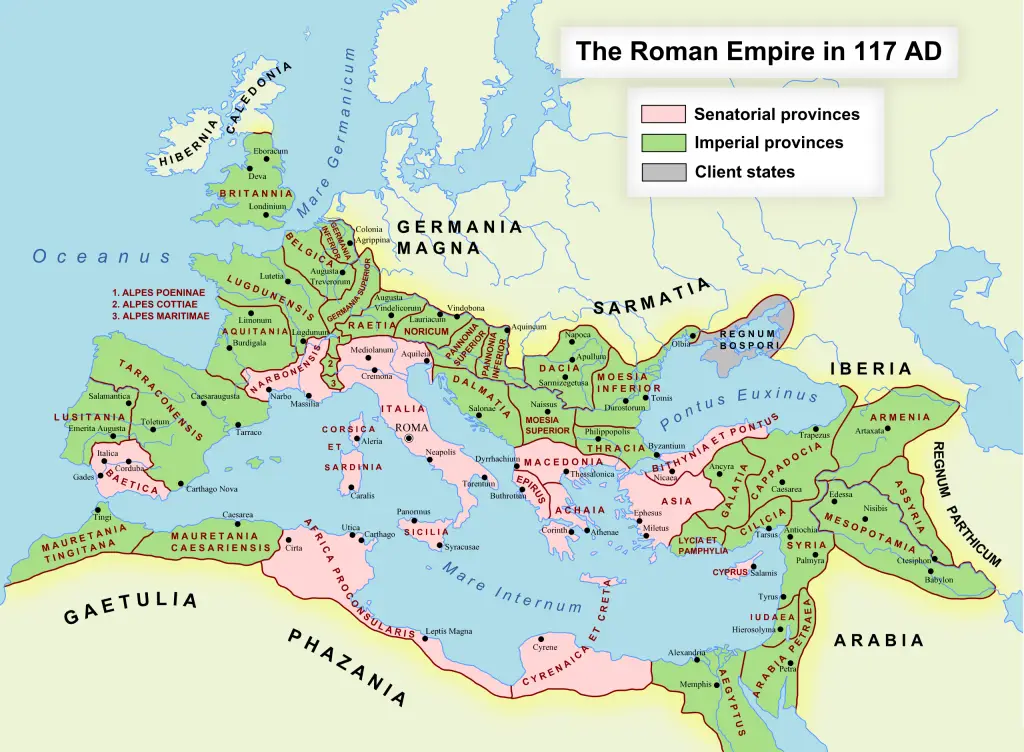
Roman Empire in the early second century
(Wiki Image By ArdadN at English Wikipedia – Transferred from en.wikipedia to Commons., Public Domain, https://commons.wikimedia.org/w/index.php?curid=3274724)
Maintaining a large and far-flung military became increasingly expensive, draining the empire’s finances.
Examples:
| Factor | Description | Impact |
| Expanding Frontiers | The Roman Empire reached its greatest extent in the 2nd century CE, requiring a massive military to defend its borders. | Increased troop numbers and logistical costs. |
| Constant Warfare | The empire faced constant threats from barbarians, internal rebellions, and civil wars. | Necessitated a large standing army and frequent military campaigns, draining the treasury. |
| Rising Soldier Pay and Benefits | To maintain morale and loyalty, emperors often increased soldier pay and benefits. | Put a further strain on the imperial budget. |
| Mercenary Recruitment | As Roman citizens became less willing to serve in the army, the empire increasingly relied on expensive foreign mercenaries. | Drained financial resources and potentially reduced army loyalty and effectiveness. |
| Military Infrastructure | Building and maintaining forts, roads, and supply lines across the vast empire was a significant expense. | Diverted funds from other essential public services. |
Export to Sheets
Impact of Military Overspending:
| Factor | Description |
| Economic Strain | Military expenditure consumed much of the imperial budget, leaving less for infrastructure, public services, and economic development. |
| Increased Taxation | The government imposed heavy taxes on the population to fund the military, leading to economic hardship and social unrest. |
| Inflation | The government often resorted to debasing the currency to pay for the military, leading to inflation and further economic instability. |
| Political Instability | Competition for resources between the military and civilian sectors contributed to political infighting and instability. |
| Weakened Defenses | Ironically, despite the massive spending, the overstretched military became less effective, making the empire more vulnerable to invasion. |
Export to Sheets
Overall Impact:
Military overspending was a major contributing factor to the decline of the Roman Empire. It placed a tremendous burden on the economy, fueled social unrest, and ultimately weakened the empire’s ability to defend itself.
Fall of the Western Roman Empire. Decline in Military Discipline: The Roman legions, once renowned for their discipline and effectiveness, suffered from declining morale and training standards. Table. Examples.
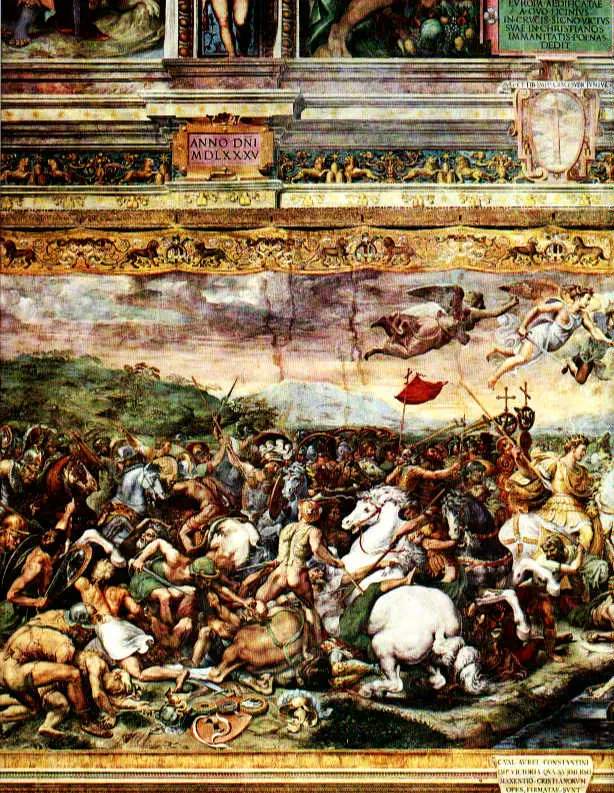
Constantine at the Battle of the Milvian Bridge, fresco by Raphael, Vatican Rooms.
(Wiki Image By School of Raphael – Constantine at the Battle of Milvian Bridge, Public Domain, https://commons.wikimedia.org/w/index.php?curid=679484)
Once renowned for their discipline and effectiveness, the Roman legions suffered from declining morale and training standards.
Examples:
| Factor | Description | Impact |
| Reduced Training | Due to constant warfare and financial constraints, soldiers received less rigorous training. | This led to a decline in combat skills and tactical awareness. |
| Lower Recruitment Standards | As Roman citizens became less willing to serve, the army increasingly relied on conscripts and barbarians with lower motivation and loyalty. | Diluted the traditional Roman military ethos and discipline. |
| Corruption and Inefficiency | Corruption among officers and administrators led to inadequate supplies, poor logistics, and a decline in morale. | Reduced the army’s effectiveness and fighting capacity. |
| Loss of Veteran Soldiers | Constant wars and internal conflicts led to the loss of experienced veteran soldiers. | Deprived the army of crucial leadership and expertise. |
| Civil Wars | Frequent civil wars diverted military resources and eroded loyalty within the army. | Weakened the army’s overall strength and cohesion. |
| Comfort and Luxury | Some historians argue that prolonged periods of peace and prosperity led to a decline in the soldiers’ hardship and fighting spirit. | Reduced their willingness to endure the rigors of military life and combat. |
Export to Sheets
Impact of Declining Military Discipline:
| Factor | Description |
| Military Effectiveness | The Roman army became less capable of effectively defending the empire’s borders and suppressing internal revolts. |
| Vulnerability to Invasion | A less disciplined and effective army made the empire more susceptible to barbarian incursions and conquests. |
| Loss of Territory | The decline in military prowess contributed to the empire’s gradual loss of territory to invading forces. |
| Political Instability | A weakened military could not maintain order and stability within the empire, contributing to political chaos. |
Export to Sheets
Overall Impact:
The decline in military discipline was a significant factor in the fall of the Roman Empire. It eroded the strength and effectiveness of the once-mighty legions, making the empire vulnerable to internal and external threats.
Fall of the Western Roman Empire. Recruitment Difficulties: The empire struggled to recruit and maintain a strong military force, relying increasingly on foreign mercenaries, weakening the army’s loyalty and effectiveness. Table. Examples.
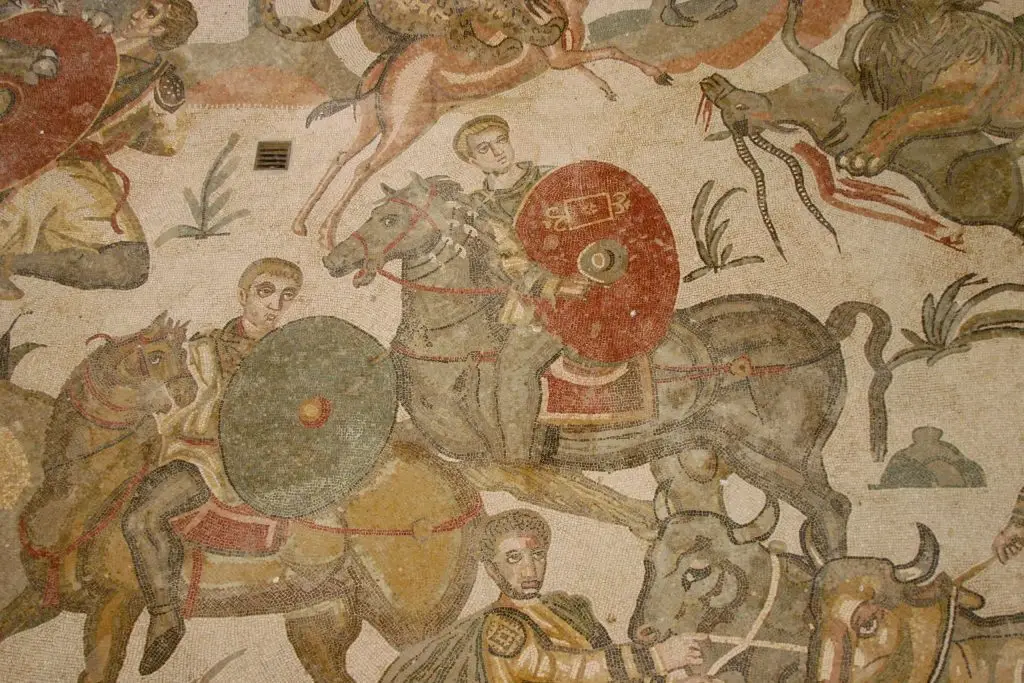
Roman cavalry from a mosaic of the Villa Romana del Casale, Sicily, 4th century AD
(Wiki Image By © José Luiz Bernardes Ribeiro, CC BY-SA 4.0, https://commons.wikimedia.org/w/index.php?curid=38677506)
You’re right. The difficulties in recruiting and maintaining a strong, loyal military force were a critical factor in the decline and fall of the Western Roman Empire. The increasing reliance on foreign mercenaries, while a temporary solution, ultimately contributed to the empire’s instability and vulnerability. Let’s examine this in detail with a table:
The Fall of the Western Roman Empire: Military Recruitment Difficulties and Reliance on Mercenaries
| Aspect of Recruitment Difficulties | Description | Examples in the Late Western Roman Empire |
| Decline in Willingness to Serve | Fewer Roman citizens were willing to enlist in the army, especially in the later centuries. | 1. The traditional association of military service with Roman citizenship and civic virtue eroded as the empire became more corrupt and less stable. <br> 2. Wealthy Romans often paid a tax (the aurum tironicum) to avoid military service, depriving the army of potential recruits from the elite. <br> 3. The dangers and hardships of military life, especially on the increasingly unstable frontiers, became less appealing. |
| Shrinking Population Base | The population of the Western Roman Empire may have declined due to various factors like disease, war, and economic hardship, reducing the pool of potential recruits. | 1. Plagues, such as the Antonine Plague (165-180 AD) and the Plague of Cyprian (249-262 AD), are estimated to have killed millions, significantly reducing the population. The later Plague of Justinian also had a devastating effect on the population. <br> 2. Constant warfare and internal conflict also took a toll on the population. <br> 3. Lower birth rates in some areas due to economic instability and social changes. |
| Economic Factors | The declining economy made it difficult for the state to pay soldiers adequately and consistently, leading to low morale and mutinies. | 1. Inflation and debasement of the currency reduced the real value of soldiers’ pay. <br> 2. The state often struggled to collect enough taxes to fund the army. <br> 3. Soldiers sometimes resorted to looting or extortion to supplement their income, further alienating the civilian population. |
| Reliance on Mercenaries (Foederati) | The empire increasingly relied on hiring foreign mercenaries, particularly Germanic tribes, to fill the army ranks. | 1. The Goths, Vandals, Franks, Huns, and other groups were recruited to fight for the Roman Empire, often under their leaders and with their customs. <br> 2. The foederati were often granted land within the empire in exchange for military service. <br> 3. The Battle of Adrianople (378 AD), where Gothic foederati defeated a Roman army, demonstrated the dangers of this reliance. |
| Consequences of Mercenary Reliance | 1. Questionable loyalty: Mercenaries often had little loyalty to the Roman Empire, and their primary motivation was often personal gain. <br> 2. Cultural clashes: Differences in language, customs, and military traditions could lead to friction and conflict. <br> 3. Rise of barbarian generals: Ambitious mercenary leaders could gain significant power and influence, sometimes even controlling or overthrowing emperors. <br> 4. Weakening of Roman military traditions: The influx of foreign troops led to a decline in traditional Roman military discipline and tactics. <br> 5. Increased risk of rebellion: Mercenary armies could, and often did, rebel against the empire if they were not paid or felt mistreated. | 1. Alaric I, a Visigothic leader who had served in the Roman army, sacked Rome in 410 AD. <br> 2. The Vandal king Gaiseric, who also had a history in the Roman military, established a kingdom in North Africa and sacked Rome in 455 AD. <br> 3. The Western Roman general, Flavius Odoacer, who was of either Scirian or Goth descent, deposed the last Western Roman emperor, Romulus Augustulus, in 476 AD. <br> 4. Generals like Stilicho, Aetius, and Ricimer, who were of barbarian origin, wielded enormous power in the late Western Roman Empire, often acting as kingmakers or de facto rulers. |
| Impact on the Empire | The difficulties in recruiting and maintaining a loyal and effective army devastated the Western Roman Empire. | 1. The empire became increasingly vulnerable to barbarian invasions and internal revolts. <br> 2. Once the backbone of Roman power, the army became a source of instability and a tool for ambitious generals and barbarian leaders. <br> 3. The reliance on mercenaries further weakened the Roman identity and eroded the traditional values that had once held the empire together. <br> 4. The inability to defend its borders led to the loss of territory and, ultimately, the collapse of the Western Roman Empire. |
Export to Sheets
In Conclusion:
The Western Roman Empire’s inability to recruit and maintain a strong, loyal military force significantly affected its decline and fall. The decline in Roman citizens’ willingness to serve, economic problems, and a shrinking population base forced the empire to rely increasingly on foreign mercenaries. This reliance, while providing a temporary solution, ultimately proved disastrous. The foederati often lacked loyalty to Rome, were prone to rebellion, and contributed to the rise of powerful barbarian generals who eventually dismantled the Western Roman Empire from within. The once mighty Roman army, a symbol of Roman power and discipline, became a shadow of its former self, contributing significantly to the empire’s demise.
Fall of the Western Roman Empire. Loss of Military Technology: The Roman military lost its technological edge, failing to keep pace with its enemies’ innovations. Table. Examples.

Parthian cataphract fighting a lion. The main striking force of the Parthian army was its cataphracts, heavy cavalry with man and horse decked in mailed armor.
(Wiki Image By British Museum, Public Domain, https://commons.wikimedia.org/w/index.php?curid=1247163)
The Roman military lost its technological edge, failing to keep pace with its enemies’ innovations.
While the Romans were renowned for their engineering prowess and military technology, they struggled to maintain their advantage over time. This stagnation and even regression in some areas affected the empire’s decline.
Examples:
| Area | Description | Impact |
| Cavalry | The Romans, traditionally focused on heavy infantry, were slow to adapt to the increasing importance of cavalry in warfare. | They were often outmaneuvered by enemies like the Parthians and Huns, who excelled in horse archery and mobile tactics. |
| Siege Warfare | While the Romans were masters of siege warfare, their technology stagnated, and they faced new challenges from fortified settlements and innovative defenses. | This made conquering and subduing enemies more difficult and costly. |
| Armor and Weaponry | The Romans faced enemies with increasingly effective armor and weapons, like the chainmail and composite bows used by the Sassanid Persians. | Roman soldiers became more vulnerable, and their weapons were less effective against these advancements. |
| Naval Technology | The Romans maintained a strong navy but failed to innovate significantly in shipbuilding and naval warfare. | This left them vulnerable to new tactics and technologies employed by enemies like the Vandals, who disrupted Roman trade and control of the Mediterranean. |
| Adaptability | The Roman military became less adaptable and innovative in its tactics and strategies, often relying on traditional methods even when they were no longer effective. | This made them predictable and vulnerable to enemies who employed new and unexpected approaches. |
Export to Sheets
Impact of Loss of Technological Edge:
| Factor | Description |
| Military Effectiveness | The Roman military became less effective in combat as its technology failed to keep pace with its enemies. |
| Increased Casualties | Roman soldiers suffered higher casualties against enemies with superior weaponry and tactics. |
| Loss of Territory | The inability to adapt and innovate contributed to the empire’s gradual loss of territory to invading forces. |
| Financial Strain | Developing and implementing new technologies would have required significant financial investment, which the struggling empire could ill afford. |
Export to Sheets
Overall Impact:
The loss of its technological edge was a significant factor in the decline of the Roman military and, consequently, the Roman Empire. The empire’s inability to adapt and innovate in the face of new challenges left it vulnerable to its enemies and eventually collapsed.
Fall of the Western Roman Empire. Lack of Vision and Strategic Thinking: Many emperors lacked a long-term vision for the empire and focused on short-term gains or personal ambitions. Table. Examples.
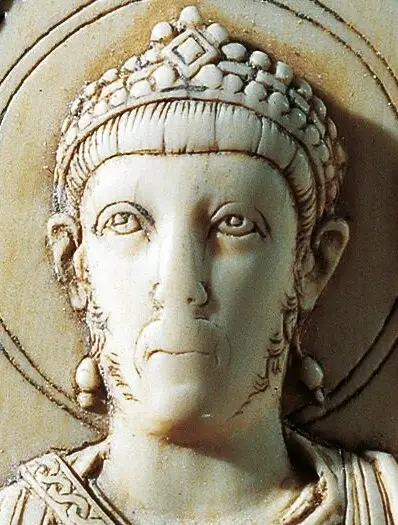
Detail of Honorius as depicted on the consular diptych of Probus, AD 406
(Wiki Image By unknown Roman artist (diptych)Dea Picture Library (photo) – Seuso Treasure, Public Domain, https://commons.wikimedia.org/w/index.php?curid=120091340)
Many emperors lacked a long-term vision for the empire and focused on short-term gains or personal ambitions.
The Roman Empire suffered from a lack of consistent, long-term strategic thinking and leadership, particularly during its later years. Many emperors prioritized personal gain or short-term solutions, neglecting the underlying problems that ultimately contributed to the empire’s decline.
Examples:
| Emperor | Period | Actions & Impact |
| Commodus | 177-192 CE | – Neglecting state affairs for personal pleasures and gladiatorial combat. <br> – This led to political instability and corruption, weakening the empire’s administration. |
| Elagabalus | 218-222 CE | – Focused on religious reforms and bizarre personal behavior, alienating the senate and the people. <br> – His actions further destabilized the empire and eroded public trust. |
| Honorius | 395-423 CE | – Failed to effectively address the growing threat of barbarian invasions, focusing on internal disputes and court intrigues. <br> – This allowed the Visigoths to sack Rome in 410 CE and further weaken the Western Roman Empire. |
| Romulus Augustulus | 475-476 CE | – The last Western Roman Emperor, he was a figurehead controlled by his father, the general Orestes. <br> – He lacked the experience and authority to address the empire’s deep-seated problems, leading to its collapse. |
Export to Sheets
Impact of Lack of Vision and Strategic Thinking:
| Factor | Description |
| Political Instability | Short-sighted leadership and internal conflicts led to frequent changes in emperors, civil wars, and overall political instability. |
| Weakened Institutions | The neglect of long-term planning and strategic thinking weakened key institutions like the army, the administration, and the economy. |
| Missed Opportunities | Emperors often failed to address critical challenges like barbarian invasions, economic decline, and social unrest, leading to missed opportunities for reform and recovery. |
| Loss of Public Trust | Focusing on personal gain and short-term solutions eroded public trust in the government and its ability to address the empire’s problems. |
Export to Sheets
Overall Impact:
Many Roman emperors’ lack of vision and strategic thinking contributed significantly to the empire’s decline and fall. It led to political instability, weakened institutions, and a failure to address the empire’s long-term challenges. This ultimately made the empire vulnerable to internal and external threats, leading to its eventual collapse.
Fall of the Western Roman Empire. Rise of New Powers: The emergence of powerful new empires, such as the Sassanian Empire in Persia, challenged Roman dominance. Table. Examples.
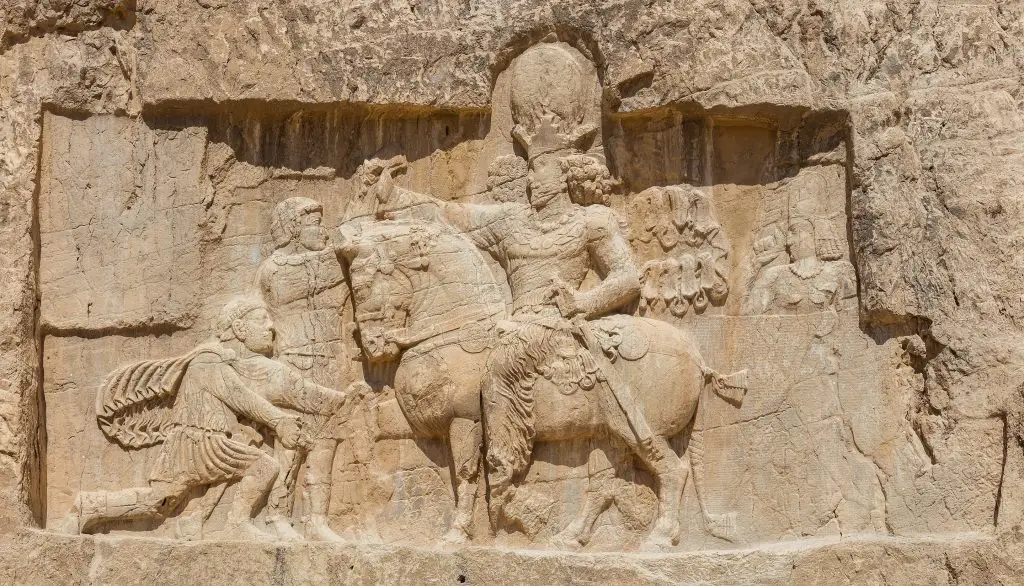
Rock-face relief at Naqsh-e Rostam of Persian emperor Shapur I (on horseback) capturing Roman emperor Valerian (standing) and Philip the Arab (kneeling), suing for peace, following the victory at Edessa (260 AD). (The Battle of Edessa took place between the Roman Empire’s armies under Emperor Valerian’s command and the Sasanian Empire under Shapur I in Edessa (now the Turkish city of Urfa) in 260. The Roman army was defeated and captured by the Sasanian forces; for the first time, a Roman emperor was taken prisoner.
(Wiki Image By Diego Delso, CC BY-SA 4.0, https://commons.wikimedia.org/w/index.php?curid=52061183)
The emergence of powerful new empires, such as the Sassanian Empire in Persia, challenged Roman dominance.
Rising powers on its frontiers put the Roman Empire under increasing pressure. These new empires posed military threats, competed for resources, and destabilized the existing geopolitical order, contributing to Rome’s decline.
Examples:
| Empire | Period | Impact on the Roman Empire |
| Sassanian Empire (Persia) | 224-651 CE | – Powerful and well-organized empire that challenged Roman control in the East. <br> – Frequent wars with the Sassanids drained Roman resources and manpower. <br> – Introduced new military technologies and tactics that challenged Roman military dominance. |
| Gupta Empire (India) | 320-550 CE | – Controlled important trade routes to the East, impacting Roman trade and access to valuable resources. <br> – The Gupta Empire’s prosperity indirectly weakened Rome by shifting economic power eastward. |
| Hunnic Empire | 4th and 5th centuries CE | – A nomadic empire that exerted pressure on both the Eastern and Western Roman Empires. <br> – Hunnic invasions and raids destabilized Roman frontiers and contributed to the collapse of the Western Roman Empire. |
| Germanic Kingdoms | 5th and 6th centuries CE | – Various Germanic tribes (Visigoths, Vandals, Franks, etc.) established powerful kingdoms within former Roman territory. <br> – These kingdoms fragmented the Western Roman Empire and contributed to its final collapse. |
Export to Sheets
Impact of the Rise of New Powers:
| Factor | Description |
| Military Pressure | New empires posed significant military threats, forcing the Romans to expend resources and manpower to defend their borders. |
| Economic Competition | Rising powers competed with Rome to control trade routes and access to valuable resources, weakening the Roman economy. |
| Geopolitical Instability | The emergence of new powers disrupted the existing geopolitical order, creating a more volatile and unpredictable environment for the Roman Empire. |
| Loss of Territory | The Romans gradually lost control of significant territories to these rising powers, further weakening the empire. |
Export to Sheets
Overall Impact:
The rise of new powers was a substantial factor in the Fall of the Western Roman Empire. These new empires challenged Roman dominance militarily, economically, and politically, contributing to the empire’s gradual weakening and eventual collapse.
Fall of the Western Roman Empire. Sack of Rome by the Visigoths (410 AD): This event shocked the Roman world and symbolized the decline of Roman power. Table. Examples.
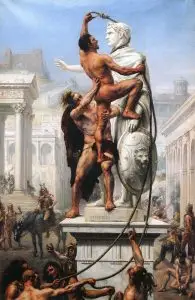
The Sack of Rome in 410 by the Barbarians by Joseph-Noël Sylvestre, 1890
(Wiki Image By Joseph-Noël Sylvestre – Das Königreich der Vandalen, ed. Klaus Hattler (Mainz: Philipp von Zabern, 2009), p. 418.scan and upload: James Steakley, Public Domain, https://commons.wikimedia.org/w/index.php?curid=10604542)
This event shocked the Roman world and symbolized the decline of Roman power.
The Visigoths’ sack of Rome in 410 AD was a watershed moment in Roman history. It marked the first time in nearly 800 years that the city had fallen to a foreign enemy, sending shockwaves throughout the empire and beyond.
Examples of the Sack’s Impact:
| Area | Description |
| Psychological Impact | The sack shattered the aura of invincibility that had long surrounded Rome. It symbolized the decline of Roman power and the empire’s vulnerability to external threats. |
| Political Impact | The event further weakened the authority of the Western Roman Emperor and exposed the limitations of the empire’s military. It also fueled political instability and internal conflicts. |
| Economic Impact | The Visigoths looted the city, carrying off vast amounts of treasure and disrupting trade and economic activity. This further weakened the already struggling Roman economy. |
| Social Impact | The sack led to widespread fear and insecurity among the Roman population. It also contributed to social unrest and the decline of traditional Roman values and institutions. |
| Religious Impact | Some interpreted the sack as a sign of divine displeasure with the Roman Empire, particularly Christian writers who saw it as punishment for paganism or moral decay. This contributed to the ongoing religious transformations within the empire. |
Export to Sheets
Overall Impact:
The sack of Rome by the Visigoths in 410 AD was a momentous event that had profound consequences for the Roman Empire. It symbolized the decline of Roman power, shook the confidence of the Roman people, and contributed to the further weakening and eventual collapse of the Western Roman Empire. Although Rome would endure for another century, the sack marked a turning point in its history and left an indelible mark on the collective memory of the Roman world.
Fall of the Western Roman Empire. Deposition of Romulus Augustulus (476 AD): The Germanic chieftain Odoacer deposed the last Western Roman Emperor, traditionally marking the end of the Western Roman Empire. Table. Examples.
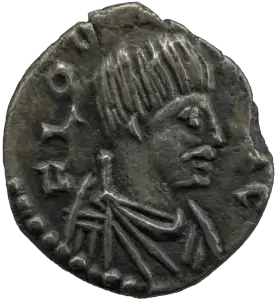
Coin of Odoacer minted in Ravenna, 477, with Odoacer in profile, depicted with a “barbarian” mustache
(Wiki Image By British Museum (photo) – British Museum, CC BY-SA 4.0, https://commons.wikimedia.org/w/index.php?curid=121565758)
The Germanic chieftain Odoacer deposed the last Western Roman Emperor, traditionally marking the end of the Western Roman Empire.
Odoacer’s deposition of Romulus Augustulus in 476 AD is often cited as the definitive end of the Western Roman Empire. Although the empire had declined for centuries, this event marked a symbolic break from the past and the beginning of a new era in European history.
Examples of the Event’s Significance:
| Area | Description |
| Symbolic End of an Era | Romulus Augustulus was the last emperor to rule from Rome. His deposition symbolized the final collapse of Roman imperial authority in the West. |
| Rise of Germanic Kingdoms | Odoacer, a Germanic chieftain, established his kingdom in Italy, signifying the rise of new Germanic powers in former Roman territories. |
| Shift in Power | The deposition marked a significant shift in power from the Roman Empire to the emerging Germanic kingdoms, altering the political landscape of Europe. |
| End of Roman Tradition | The event disrupted centuries of Roman tradition and governance, leading to the decline of Roman institutions and culture in the West. |
| Beginning of the Middle Ages | The deposition of Romulus Augustulus is often used to mark the beginning of the Middle Ages, a period of significant transformation in European history. |
| Legacy of the Roman Empire | Despite its fall, the Roman Empire left a lasting legacy on Western civilization, including its language, law, architecture, and culture. |
Export to Sheets
Overall Impact:
The deposition of Romulus Augustulus in 476 AD was a pivotal event that marked the end of the Western Roman Empire. It symbolized the decline of Roman power, the rise of new Germanic kingdoms, and the beginning of a new era in European history. While the Eastern Roman Empire (Byzantine Empire) continued to exist for another thousand years, the Western Empire’s fall profoundly impacted the development of Western civilization.
Cultural and Religious Changes
Fall of the Western Roman Empire. Rise of Christianity: The spread of Christianity challenged traditional Roman values and religious practices, contributing to social and political divisions. Table. Examples.
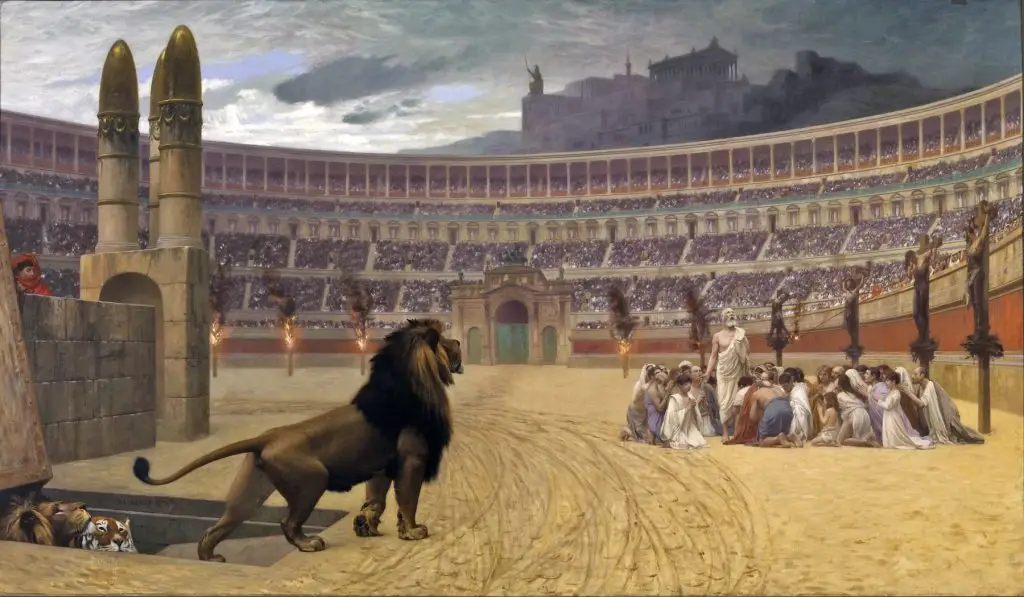
The Christian Martyrs’ Last Prayer, by Jean-Léon Gérôme (1883)
(Wiki Image By Jean-Léon Gérôme – Walters Art Museum: Home page Info about artwork, Public Domain, https://commons.wikimedia.org/w/index.php?curid=18824108)
The spread of Christianity challenged traditional Roman values and religious practices, contributing to social and political divisions.
While Christianity ultimately became the Roman Empire’s official religion, its rise contributed to internal tensions and divisions during significant instability.
Examples:
| Aspect | Description | Impact |
| Religious Differences | Christianity’s monotheism clashed with traditional Roman polytheism and emperor worship. | This led to the persecution of Christians and social unrest. |
| Social Values | Christian emphasis on humility, poverty, and pacifism contrasted with Roman values of military strength, wealth, and civic duty. | This created tension and sometimes conflict between Christians and traditional Roman society. |
| Political Authority | The Christian Church developed its hierarchy and authority, potentially challenging the authority of the Roman Emperor. | This led to conflicts between Church and state, particularly regarding religious freedom and political influence. |
| Martyrdom | The persecution of early Christians created martyrs whose examples inspired further conversions and strengthened Christian identity. | This inadvertently fueled the growth of Christianity, even as it created social divisions. |
| Constantine’s Conversion | Emperor Constantine’s conversion to Christianity in the 4th century CE led to official toleration and eventual dominance of Christianity. | This significantly changed the religious landscape of the empire but also led to new internal divisions between Christian factions and those who adhered to traditional Roman religion. |
Export to Sheets
Impact of the Rise of Christianity:
| Factor | Description |
| Social Divisions | The spread of Christianity created religious and social divisions within Roman society, potentially weakening its cohesion. |
| Political Instability | Conflicts between the Christian Church and the Roman state contributed to political instability during a period of already significant challenges. |
| Cultural Change | Christianity’s rise led to significant cultural changes within the Roman Empire, transforming its values, traditions, and institutions. |
| Religious Persecution | The persecution of Christians created martyrs and fueled resentment, further contributing to social unrest. |
| Unifying Force | Paradoxically, Christianity also provided a unifying force within the increasingly fragmented empire, offering a common faith and shared identity. |
Export to Sheets
Overall Impact:
The rise of Christianity was a complex and multifaceted phenomenon that profoundly impacted the Roman Empire. While it ultimately became a unifying force, its early spread contributed to social and political divisions during a significant decline. Christianity’s challenge to traditional Roman values and religious practices played a role in the empire’s transformation and eventual fall, even as it laid the foundation for a new Christian Europe.
Fall of the Western Roman Empire. Loss of Traditional Values: The decline of traditional Roman values, such as civic duty and military discipline, weakened the social fabric of the empire. Table. Examples.
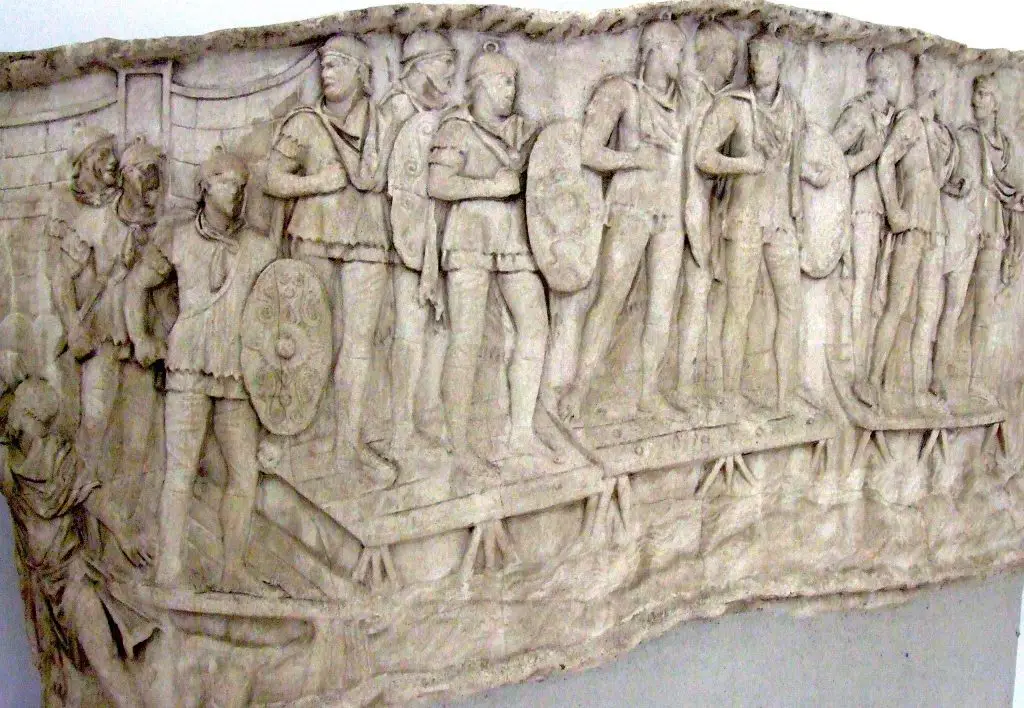
Roman auxiliary infantry crossing a river. They can be distinguished by the oval shield (clipeus) they were equipped with, in contrast to the rectangular scutum carried by legionaries. Panel from Trajan’s Column, Rome
(Wiki Image By CristianChirita – Photo by CristianChirita, CC BY-SA 3.0, https://commons.wikimedia.org/w/index.php?curid=819821)
The decline of traditional Roman values, such as civic duty and military discipline, weakened the empire’s social fabric.
The Roman Empire’s strength was built on its military and political institutions and a foundation of shared values and social cohesion. As these values eroded, the empire became more vulnerable to internal strife and external threats.
Examples:
| Value | Description | Impact of Decline |
| Civic Duty | Citizens were expected to participate actively in public life, serving in government, the military, and other civic roles. | A decline in civic duty led to apathy, corruption, and weakening public institutions. |
| Military Discipline | The Roman legions were renowned for their discipline and training, essential to their effectiveness. | A decline in military discipline led to a less effective army, making the empire more vulnerable to invasion. |
| Patriotism | Romans were expected to be loyal and devoted to the empire and its institutions. | A decline in patriotism led to a lack of unity and a weakening of the empire’s social fabric. |
| Stoicism | This philosophy emphasized self-control, duty, and reason. | The decline of Stoicism contributed to a loss of moral guidance and a rise in hedonism and self-interest. |
| Frugality and Simplicity | Traditional Roman values emphasized frugality and simplicity in lifestyle. | The increased luxury and extravagance among the elite contributed to social inequality and moral decay. |
Export to Sheets
Impact of the Loss of Traditional Values:
| Factor | Description |
| Social Fragmentation | The decline of shared values led to social fragmentation and a loss of common purpose. |
| Political Instability | Apathy and corruption undermined political institutions and contributed to instability. |
| Military Weakness | A decline in military discipline and patriotism weakened the army and made the empire more vulnerable to external threats. |
| Moral Decay | The loss of traditional values contributed to a decline in moral standards and a rise in hedonism and self-interest. |
Export to Sheets
Overall Impact:
The decline of traditional Roman values was a significant factor in the weakening and eventual fall of the Roman Empire. It eroded the social cohesion and moral fiber that had once been the foundation of the empire’s strength, making it more susceptible to internal strife and external threats.
Fall of the Western Roman Empire. Loss of the Virtue of “Pietas”: Traditional Roman respect for gods, family, and the state diminished. Table. Examples.
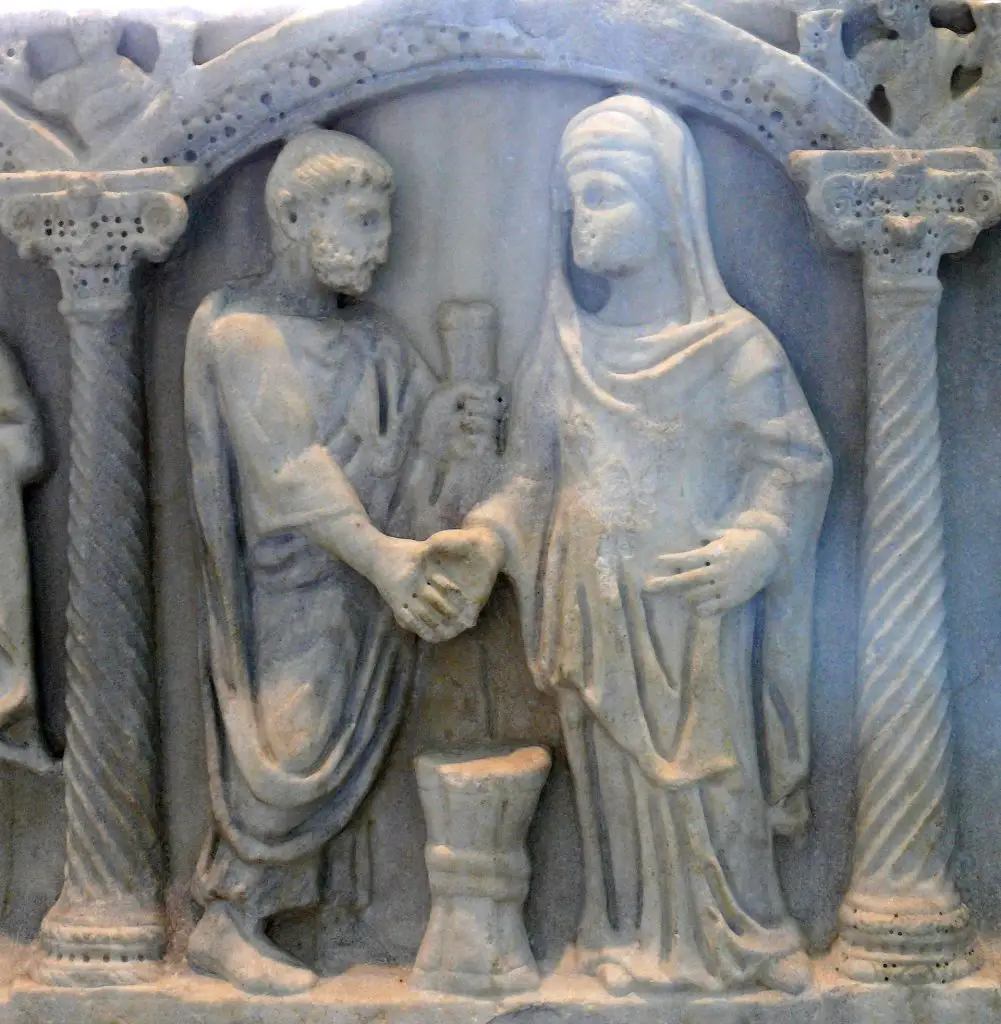
Roman marriage vows
(Wiki Image By Ad Meskens – Own work, CC BY-SA 3.0, https://commons.wikimedia.org/w/index.php?curid=11157494)
Traditional Roman respect for gods, family, and the state diminished.
Pietas was a fundamental virtue in Roman society, encompassing loyalty, duty, and reverence towards the gods, family, and the state. The erosion of this core value contributed to the weakening of social bonds and the decline of the Roman Empire.
Examples:
| Aspect of Pietas | Description | Impact of Decline |
| Respect for the Gods | Romans were expected to honor the gods through rituals, sacrifices, and observance of religious festivals. | – Decline in religious observance and rise of alternative religions and philosophies weakened traditional social bonds and moral authority. <br> – This contributed to spiritual uncertainty and a loss of faith in traditional institutions. |
| Family Loyalty | Strong family ties were essential to Roman society, emphasizing respect for elders, parental authority, and familial obligations. | – The weakening of family bonds led to a breakdown in social order and a decline in the transmission of traditional values. <br> – This contributed to social instability and decreased support networks. |
| Loyalty to the State | Citizens were expected to be loyal and devoted to the Roman state, serving in the military and participating in civic life. | – Decline in patriotism and civic duty led to apathy, corruption, and weakening public institutions. <br> – This made maintaining a strong military and effective government difficult. |
| Respect for Authority | Romans were expected to respect and obey those in positions of authority, from parents and elders to magistrates and emperors. | – Disrespect for authority undermined social order and increased lawlessness and instability. <br> – This made enforcing laws and maintaining order within the empire brutal. |
| Sense of Duty | Romans were expected to fulfill their duties to their family, community, and the state. | – A decline in the sense of duty led to a lack of personal responsibility and a focus on self-interest. <br> – This contributed to a breakdown in social cohesion and weakened the empire’s moral fiber. |
Export to Sheets
Impact of the Loss of Pietas
| Factor | Description |
| Social Decay | The erosion of pietas led to a breakdown in social cohesion, weakening the bonds that held Roman society together. |
| Political Instability | A decline in loyalty to the state and respect for authority contributed to political instability and corruption. |
| Military Weakness | A decline in patriotism and a sense of duty weakened the military and made the empire more vulnerable to external threats. |
| Moral Decline | The loss of pietas contributed to a decline in moral standards and a rise in hedonism and self-interest. |
Export to Sheets
Overall Impact:
The loss of Pietas was a significant factor in the Fall of the Western Roman Empire. It eroded the core values that had once been the foundation of Roman society, weakening its social fabric, political institutions, and military strength. This ultimately made the empire more susceptible to internal strife and external threats, contributing to its eventual collapse.
Fall of the Western Roman Empire. Cultural Decline: A decline in intellectual and artistic achievements contributed to a sense of stagnation and decline. Table. Examples.
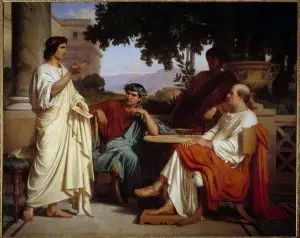
Horace, Virgil, and Varius at the house of Maecenas, by Charles Jalabert
(Wiki Image By Charles Jalabert – https://useum.org/museum/musee-des-beaux-arts-de-n%C3%AEmes, Public Domain, https://commons.wikimedia.org/w/index.php?curid=94084650)
A decline in intellectual and artistic achievements contributed to stagnation and decline.
The Roman Empire was a period of great cultural flourishing, but as the empire declined, so did its intellectual and artistic output. This decline in creativity and innovation contributed to stagnation and pessimism, weakening the empire’s spirit.
Examples:
| Area | Description | Impact |
| Literature | While early imperial Rome produced great writers like Virgil and Ovid, later periods saw a decline in originality and literary quality. | This reflected a loss of intellectual vitality and a growing sense of pessimism. |
| Art and Architecture | While Roman engineering feats continued, artistic innovation declined. Later, Roman art often imitated earlier styles or became more stylized and less realistic. | This indicated a lack of new ideas and a reliance on past glories. |
| Philosophy | While Stoicism and other philosophical schools flourished in early imperial Rome, later periods saw less original philosophical thought. | This suggested a decline in intellectual curiosity and critical thinking. |
| Science and Innovation | While the Romans were known for their engineering achievements, scientific progress stagnated in the later empire. | This limited technological advancement and economic development. |
| Education | The quality of education declined in the later empire, with less emphasis on classical learning and critical thinking. | This contributed to a decline in intellectual standards and a less informed citizenry. |
Export to Sheets
Impact of Cultural Decline:
| Factor | Description |
| Loss of Creativity and Innovation | The decline in intellectual and artistic achievements reflected a loss of creativity and innovation, essential for a thriving society. |
| Social Stagnation | Cultural stagnation contributed to a sense of pessimism and decline, weakening the social fabric of the empire. |
| Economic Decline | A lack of scientific and technological innovation hindered economic development and made the empire less competitive. |
| Loss of Identity | The decline in cultural achievements eroded Roman pride and contributed to the loss of identity. |
Export to Sheets
Overall Impact:
The cultural decline of the Roman Empire was both a symptom and a contributing factor to its overall decline. It reflected a loss of intellectual vitality, creativity, and innovation, which weakened the empire’s social fabric, economic strength, and sense of identity. This ultimately made the empire more vulnerable to internal strife and external threats, contributing to its eventual collapse.
Fall of the Western Roman Empire. Bread and circuses: The focus on entertainment and appeasement of the masses led to a decline in public morale and civic engagement. Table. Examples.
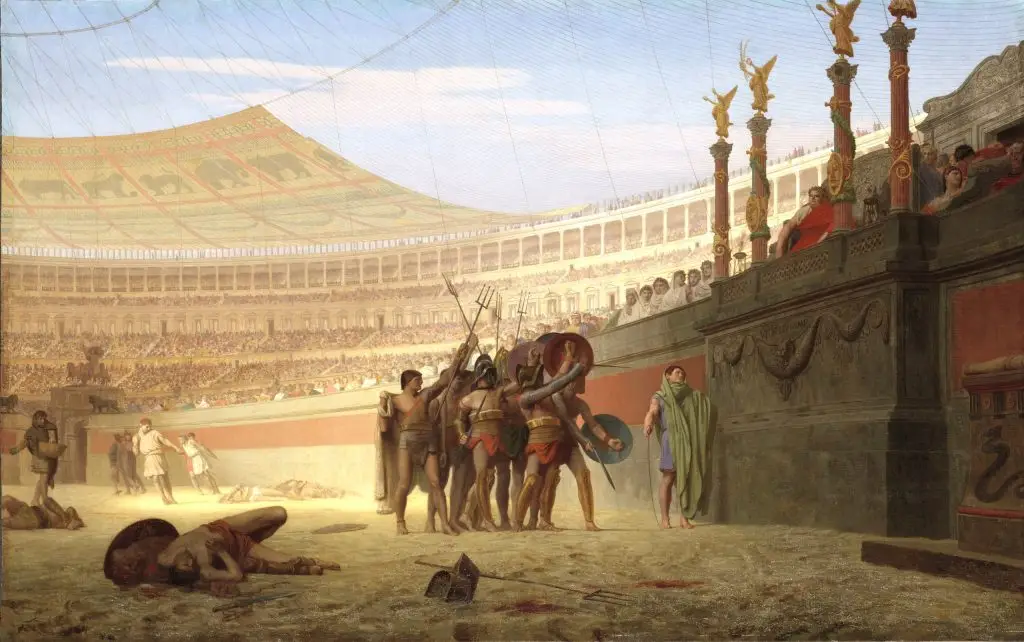
Ave Imperator, morituri te salutant (Hail, Cesar, those who will die to salute you), by Jean-Léon Gérôme, 1859
(Wiki Image By Unknown author – http://artgallery.yale.edu/collections/objects/9187, Public Domain, https://commons.wikimedia.org/w/index.php?curid=40030937)
The focus on entertainment and appeasement of the masses led to a decline in public morale and civic engagement.
The phrase “bread and circuses” (panem et circenses) originates from the Roman poet Juvenal, who criticized the Roman government for using free food and entertainment to distract the populace from political issues and civic responsibilities. While providing temporary appeasement, this practice contributed to declining public morale and engagement, weakening the empire’s social fabric.
Examples:
| Element | Description | Impact |
| Free Grain Dole | The Roman government provided free grain to the urban population to prevent food riots and maintain social order. | – Created dependency on the state and discouraged self-sufficiency. <br> – Fostered a sense of entitlement and reduced motivation for active economic participation. |
| Gladiatorial Games | Gladiatorial contests and other spectacles in the Colosseum and other arenas provided violent entertainment for the masses. | – Desensitized the population to violence and brutality. <br> – Distracted from political issues and social problems. <br> – Fostered a culture of idleness and pleasure-seeking. |
| Chariot Races | Chariot races in the Circus Maximus were incredibly popular and drew massive crowds. | – Fueled factionalism and rivalries among supporters of different racing teams. <br> – Distracted from civic duties and political participation. |
| Public Baths | Public baths provided a place for relaxation and socializing but also contributed to a culture of leisure and indulgence. | – Encouraged idleness and a decline in work ethic. <br> – Distracted from more productive activities and civic engagement. |
| Theater and Spectacles | Theaters offered comedies, tragedies, and other performances, often with free admission. | – While providing cultural enrichment, they also served as a form of escapism and distraction from real-world problems. |
Export to Sheets
Impact of Bread and Circuses:
| Factor | Description |
| Decline in Civic Engagement | The focus on entertainment and free handouts discouraged active civic and political participation. |
| Erosion of Public Morale | Pursuing pleasure and distraction led to declining public morale and a loss of civic virtue. |
| Social Fragmentation | Bread and circuses contributed to social fragmentation by diverting attention from shared goals and civic responsibilities. |
| Political Apathy | The populace became disengaged from politics, allowing emperors and the ruling class to consolidate power without accountability. |
Export to Sheets
Overall Impact:
The “bread and circuses” policy contributed to the Fall of the Western Roman Empire by eroding public morale, civic engagement, and social cohesion. While providing temporary distractions and appeasement, it weakened the empire’s social fabric and made it more vulnerable to internal strife and external threats.
Fall of the Western Roman Empire. Spread of Eastern Religions: The influence of Eastern mystery religions and philosophies contributed to a decline in traditional Roman religious practices. Table. Examples.
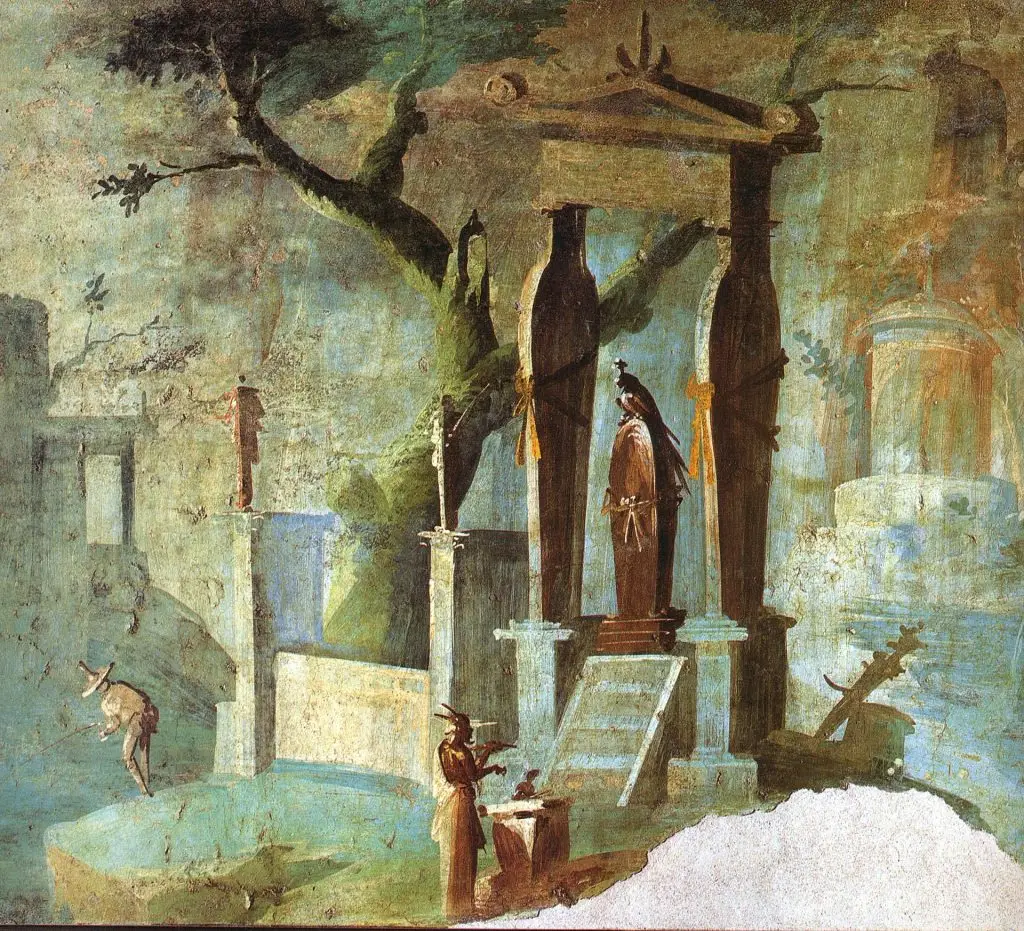
A ceremony worshipping the sarcophagus of Osiris, depicted in a fresco in the Temple of Isis at Pompeii from the first century CE. The death of Osiris was a prominent motif in the cult of Isis. The sarcophagus’s appearance here may refer to the emphasis on Osiris and the afterlife in the mysteries dedicated to Isis.
(Wiki Image By Unknown author – Marisa Ranieri Panetta (ed.): Pompeji. Geschichte, Kunst und Leben in der versunkenen Stadt. Belser, Stuttgart 2005, ISBN 3-7630-2266-X, p. 117., Public Domain, https://commons.wikimedia.org/w/index.php?curid=6222598)
The influence of Eastern mystery religions and philosophies contributed to a decline in traditional Roman religious practices.
As the Roman Empire expanded and interacted with diverse cultures, Eastern mystery religions and philosophies gained popularity. These new belief systems, emphasizing personal salvation and mystical experiences, often contrasted with traditional Roman religion, contributed to its decline and a shift in Roman spirituality.
Examples:
| Religion/Philosophy | Origin | Impact on Roman Religion |
| Mithraism | Persia | – Popular among soldiers, it emphasized loyalty, discipline, and a hierarchical structure. <br> – Offered initiation rites and a belief in the soul’s immortality. <br> – Competed with traditional Roman religion and its emphasis on civic duty and state gods. |
| Cult of Isis | Egypt | – Focused on the goddess Isis and her promise of resurrection and eternal life. <br> – Offered elaborate rituals, personal connection with the deity, and a sense of community. <br> – Appealed to those seeking emotional and spiritual fulfillment beyond traditional Roman practices. |
| Cybele (Magna Mater) | Anatolia | – Centered on the mother goddess Cybele and her consort Attis, focusing on fertility, rebirth, and emotional intensity. <br> – Involved ecstatic rituals and a strong sense of community. <br> – Offered a more emotional and mystical religious experience than traditional Roman religion. |
| Neoplatonism | Hellenistic world | – A philosophical system that blends Platonic ideas with mystical elements. <br> – Emphasized the pursuit of spiritual enlightenment and union with the divine. <br> – Offered an intellectual and spiritual alternative to traditional Roman religion. |
Export to Sheets
Impact of the Spread of Eastern Religions:
| Factor | Description |
| Religious Syncretism | Eastern religions blended with Roman beliefs and practices, creating a more diverse and syncretic religious landscape. |
| Decline in Traditional Practices | The popularity of Eastern religions contributed to a decline in traditional Roman religious practices and the authority of the state religion. |
| Shift in Values | Eastern religions introduced new values and beliefs, such as personal salvation and mystical experiences, contrasting with the traditional Roman emphasis on civic duty and state gods. |
| Spiritual Seeking | The spread of Eastern religions reflected a growing desire for personal spiritual fulfillment and connection with the divine. |
Export to Sheets
Overall Impact:
The spread of Eastern religions and philosophies was a significant factor in transforming Roman religious life. It contributed to the decline of traditional Roman religious practices and introduced new values and beliefs that challenged the existing social and religious order. This process reflected the changing cultural landscape of the late Roman Empire and contributed to the broader decline of traditional Roman institutions and values.
Fall of the Western Roman Empire. Moral Decay: Some historians point to a decline in moral values, increased decadence, and corruption contributing to the empire’s decline. Table. Examples.
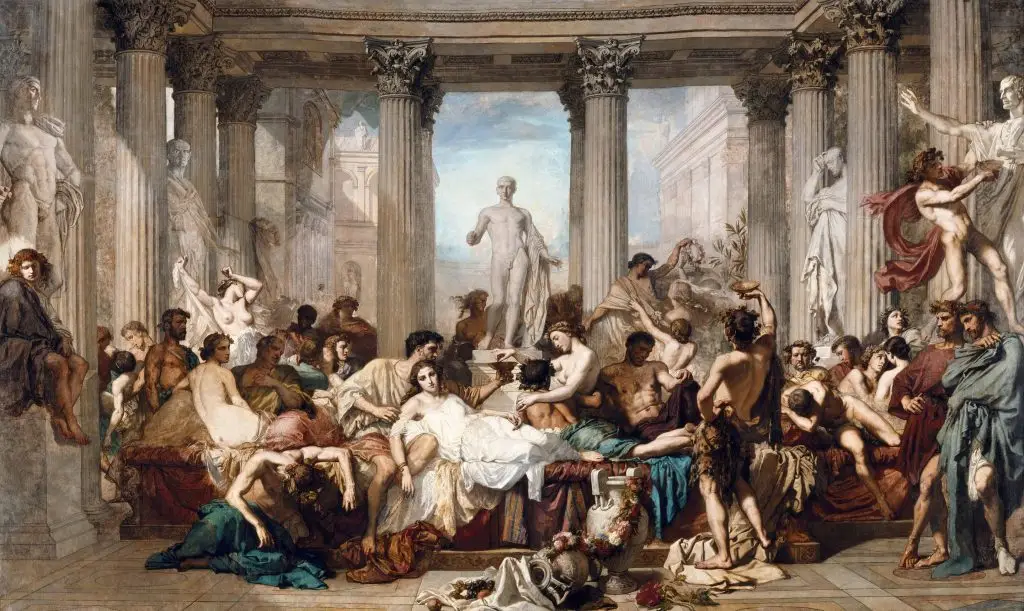
The Romans in their Decadence, French painting by Thomas Couture, 1847
(Wiki Image By Thomas Couture – Google Art Project: Home – pic Maximum resolution., Public Domain, https://commons.wikimedia.org/w/index.php?curid=20092567)
Some historians suggest that a decline in moral values, increased decadence, and corruption contributed to the empire’s decline.
While moral decay is a complex and debated topic, some historians argue that a decline in ethical standards and increased decadence weakened the Roman Empire’s social fabric and contributed to its eventual downfall.
Examples:
| Area | Description | Impact |
| Political Corruption | Corruption became rampant in the later empire, with officials accepting bribes and engaging in nepotism. | – Eroded public trust in the government. <br> – Weakened the administration and justice system. <br> – Misallocation of resources and hindered effective governance. |
| Social Decadence | Some historians argue that the Roman elite increasingly focused on luxury, extravagance, and pleasure-seeking. | – Widened the gap between rich and poor. <br> – Contributed to a decline in civic virtue and public service. <br> – Fostered a culture of hedonism and self-indulgence. |
| Loss of Civic Virtue | The traditional Roman values of civic duty, patriotism, and self-sacrifice declined. | – Reduced public engagement in civic affairs. <br> – Weakened the military and public institutions. <br> – Contributed to a sense of apathy and disengagement. |
| Erosion of Family Values | The importance of family and traditional family structures declined. | – Contributed to social instability and a breakdown in social cohesion. <br> – Weakened the transmission of traditional values and moral education. |
| Religious Decline | The decline of traditional Roman religion and the rise of new religions and philosophies led to a loss of moral guidance and spiritual certainty. | – Contributed to a sense of moral relativism and uncertainty. <br> – Weakened the social and moral authority of traditional institutions. |
Export to Sheets
Impact of Moral Decay:
| Factor | Description |
| Social Fragmentation | Moral decay eroded social cohesion and weakened the bonds that held Roman society together. |
| Political Instability | Corruption and a decline in civic virtue undermined political institutions and contributed to instability. |
| Economic Decline | Corruption and a lack of economic responsibility hindered economic growth and contributed to economic decline. |
| Military Weakness | A decline in discipline and patriotism weakened the military and made the empire more vulnerable to external threats. |
Export to Sheets
Overall Impact:
While the extent and impact of moral decay are debated, some historians consider it a contributing factor to the Fall of the Western Roman Empire. Moral decay weakened the social fabric, political institutions, and military strength, making the empire susceptible to internal strife and external threats. The loss of traditional values and the rise of decadence and corruption eroded the foundations of Roman society and contributed to its eventual collapse.
External Factors
Fall of the Western Roman Empire. Climate Change: Climatic changes, such as droughts and crop failures, contributed to economic hardship and social unrest. Table. Examples.
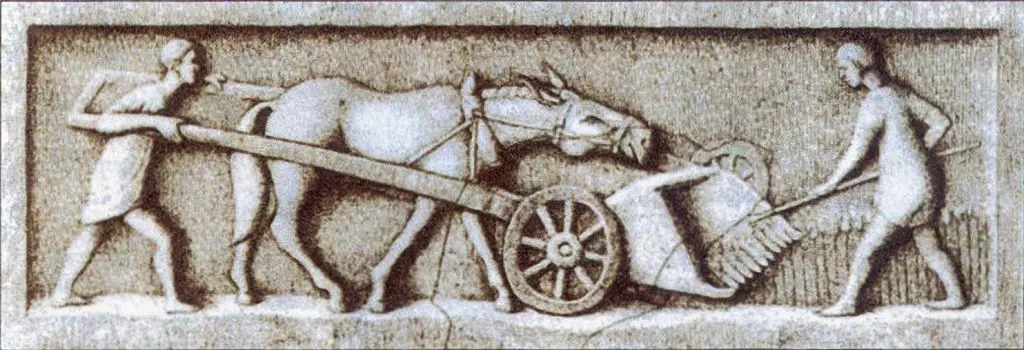
Gallo-Roman harvesting machine
(Wiki Image Public Domain, https://commons.wikimedia.org/w/index.php?curid=1717542)
That’s another crucial factor to consider. While scientists and historians still debate the exact role and extent of climate change in the fall of the Western Roman Empire, there’s growing evidence that it played a significant role. Let’s explore this through a table with examples:
The Fall of the Western Roman Empire: The Impact of Climate Change
| Aspect of Climate Change | Description | Examples and Evidence in the Late Western Roman Empire |
| Climate Variability | Shifts in temperature and precipitation patterns, including periods of drought, colder temperatures, and increased variability. | 1. The Late Antique Little Ice Age (c. 536-660 AD): Evidence from tree rings, ice cores, and historical records suggests a period of colder temperatures and increased climate variability that began during the decline of the Western Roman Empire. <br> 2. Droughts: Paleo-climatic data (e.g., from lake sediments) indicate periods of drought in various parts of the Roman Empire during the 4th and 5th centuries. <br> 3. Volcanic Eruptions: Major volcanic eruptions can inject aerosols into the atmosphere, leading to temporary cooling. There were significant volcanic eruptions around 535-547 AD. The eruption around 535-536 AD is believed to have been in the tropics. The eruption around 539-540 AD was in the Northern Hemisphere. The eruption in 547 AD may have been in Iceland. |
| Agricultural Impacts | Changes in temperature and rainfall patterns negatively affected crop yields, leading to food shortages and price increases. | 1. Reduced harvests: Historical records and archaeological evidence (e.g., pollen analysis) suggest that agricultural production declined in some regions during periods of drought or colder temperatures. <br> 2. Crop failures: More frequent crop failures due to unfavorable weather conditions. <br> 3. Increased food prices: Scarcity led to higher food prices, impacting the poor and potentially contributing to social unrest. |
| Economic Consequences | Reduced agricultural output and food shortages had negative consequences for the Roman economy. | 1. Decline in trade: Reduced agricultural surplus meant less trade. <br> 2. Tax revenue shortfalls: Lower agricultural production meant less tax revenue for the state. <br> 3. Inflation: Food scarcity could have contributed to inflation, further destabilizing the economy. <br> 4. Increased costs for food imports: The empire may have become more reliant on food imports, straining its finances. |
| Social and Political Impacts | Economic hardship, food shortages, and increased social stress due to climate variability could exacerbate existing social and political tensions. | 1. Food riots: Historical records mention food riots in Roman cities during times of scarcity. <br> 2. Migration and displacement: People may have migrated from areas affected by drought or crop failures, potentially leading to conflict and instability. <br> 3. Weakened state capacity: The Roman state’s ability to respond to crises may have been hampered by the economic and social stresses caused by climate change. <br> 4. Increased vulnerability to barbarian invasions: Climate-induced instability may have made the empire more vulnerable to attacks. |
| Disease | Climate change can indirectly influence the spread of disease. | 1. The Plague of Justinian (541-549 AD): This devastating pandemic, which may have been exacerbated by climate change, killed millions of people in the Eastern Roman Empire and likely spread to parts of the West. It may have been caused or exacerbated by the earlier volcanic eruptions. <br> 2. Malnutrition: Food shortages due to climate change could make populations more vulnerable to disease outbreaks. |
| Impact on the Empire | Climate change acted as a “threat multiplier,” exacerbating existing problems and making it harder for the Western Roman Empire to cope with the challenges it faced. | While not the sole cause, climate change likely contributed to the weakening of the Western Roman Empire by: <br> 1. Reducing food production and economic stability. <br> 2. Increasing social unrest and migration. <br> 3. Straining the state’s resources and ability to respond to crises. <br> 4. This may potentially contribute to the spread of disease. <br> 5. This made the empire more vulnerable to barbarian invasions. |
Export to Sheets
Important Considerations:
- Evidence is complex: Reconstructing past climates relies on proxy data (tree rings, ice cores, lake sediments), which can be complex and may not always provide a complete picture.
- Regional variations: The impact of climate change varied across the vast Roman Empire. Some regions may have been more affected by droughts or cold periods than others.
- Interaction with other factors: Climate change interacted with other factors, such as political instability, economic problems, barbarian migrations, and disease outbreaks, making it difficult to isolate its precise impact.
- Debate among historians and scientists: The exact role of climate change in the fall of the Western Roman Empire is still a subject of ongoing research and debate.
In Conclusion:
Climate change, particularly increased climate variability and periods of drought or colder temperatures, likely played a significant role in the decline and fall of the Western Roman Empire. It acted as a “threat multiplier,” exacerbating existing economic, social, and political problems and making it harder for the empire to cope with its challenges. While not the sole cause of the empire’s demise, climate change was an important contributing factor that should not be overlooked. It highlights the vulnerability of even the most powerful empires to environmental changes and the interconnectedness of climate, environment, economy, and society.
Fall of the Western Roman Empire: Diseases and Plagues: Epidemics like the Antonine and Cyprian Plagues decimated the population and weakened the empire. Pictures.
You’re right to point out the devastating impact of those plagues! It’s hard to find images from that time period that directly represent the plagues, but we can use images to understand the context and impact they had.
Here are some visuals to help illustrate the fall of the Western Roman Empire, with a focus on the role of diseases and plagues:
1. The Antonine Plague (165-180 AD)
- Image of a Roman physician: This image represents the medical knowledge of the time. While they understood some basics of hygiene, they lacked the understanding of germ theory and microbiology needed to combat a pandemic effectively.
Galen, a prominent Roman physician
- Image of a bustling Roman city: The Antonine Plague, likely smallpox, spread rapidly through the dense populations of Roman cities, facilitated by trade routes and movement of people.
busy Roman marketplace
- Image of a weakened Roman army: The plague severely impacted the Roman military, reducing its manpower and effectiveness. This weakened the empire’s ability to defend its borders and maintain order.
depleted Roman legion
2. The Cyprian Plague (251-270 AD)
- Image of a Roman Emperor during the Crisis of the Third Century: This image represents the political instability of the time. The plague struck during a period of frequent leadership changes, civil wars, and economic hardship, further destabilizing the empire.
Emperor Decius
- Image of a Roman coin showing debasement: The plague, along with economic woes, led to currency debasement, as the empire struggled to fund its military and maintain its infrastructure.
Roman coin with reduced silver content
- Image of barbarian incursions: With a weakened military and internal strife, the Roman Empire became more vulnerable to barbarian incursions, which further contributed to its decline.
Germanic tribes crossing the Roman border
3. The Fall of the Western Roman Empire (476 AD)
- Image of the Sack of Rome: This image represents the final blow to the Western Roman Empire. Weakened by plagues, economic decline, and internal strife, the empire could not withstand the repeated attacks from barbarian tribes.
Visigoths sacking Rome
- Image of a map showing the fragmented Western Roman Empire: This image illustrates the political fragmentation that followed the fall of the empire. The once-unified Western Roman Empire was divided into various Germanic kingdoms.
map of Europe after the fall of the Western Roman Empire
These images, while not directly depicting the plagues themselves, help to visualize the context in which they occurred and the devastating impact they had on the Roman Empire. The plagues, along with other factors, contributed to the decline and eventual fall of the Western Roman Empire in 476 AD.
Fall of the Western Roman Empire. Natural Disasters: Natural disasters like earthquakes and volcanic eruptions cause disruption and economic hardship. Table. Examples.
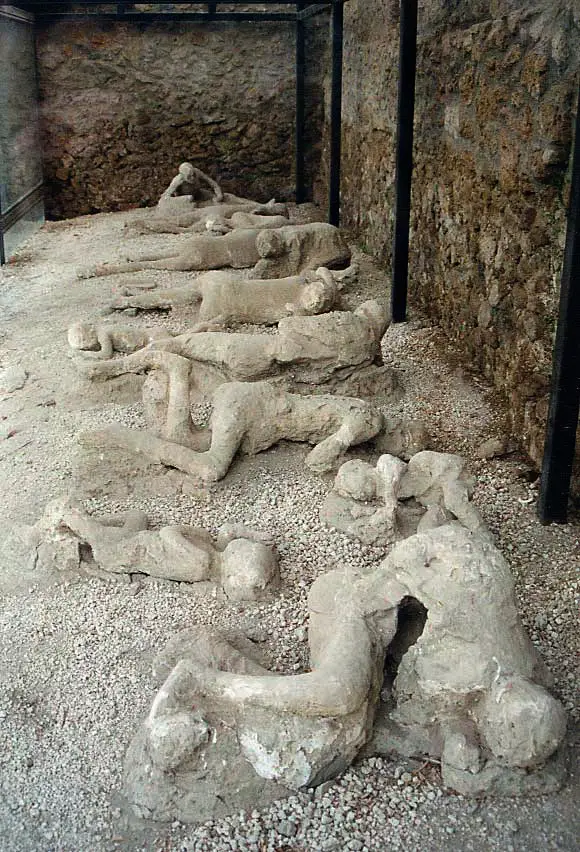
The casts of some victims in the so-called “Garden of the Fugitives,” Pompeii
(Wiki Image By Lancevortex – Own work, CC BY-SA 3.0, https://commons.wikimedia.org/w/index.php?curid=47499)
Natural disasters like earthquakes and volcanic eruptions cause disruption and economic hardship.
Despite its vastness and power, the Roman Empire was vulnerable to the forces of nature. Earthquakes, volcanic eruptions, and other natural disasters caused significant damage to infrastructure, disrupted trade, and led to economic hardship, contributing to the empire’s overall decline.
Examples:
| Disaster | Date (approx.) | Impact |
| Eruption of Mount Vesuvius | 79 CE | – Buried the cities of Pompeii and Herculaneum under volcanic ash and lava. <br> – Caused significant loss of life and property. <br> – Disrupted trade and agriculture in the region. |
| Earthquake in Antioch | 115 CE | – Devastated the city of Antioch, a major commercial and cultural center in the Eastern Roman Empire. <br> – Killed an estimated 260,000 people. <br> – Disrupted trade routes and caused significant economic damage. |
| Earthquake in Rome | 443 CE | – Caused widespread damage in Rome, including to major monuments and infrastructure. <br> – Contributed to the city’s decline and the weakening of the Western Roman Empire. |
| Volcanic Winter (536 CE) | 536 CE | – A massive volcanic eruption (possibly in North America or Iceland) caused a “volcanic winter” with reduced sunlight and cooler temperatures. <br> – Led to crop failures, famine, and widespread hardship throughout the Northern Hemisphere, including the Roman Empire. <br> – Contributed to the Late Antique Little Ice Age and further weakened the empire. |
Export to Sheets
Impact of Natural Disasters:
| Factor | Description |
| Loss of Life and Property | Natural disasters caused significant loss of life and damage to infrastructure, including homes, public buildings, and agricultural lands. |
| Economic Disruption | It disrupted trade routes, damaged agrarian production, and hindered economic activity. |
| Social Unrest | Natural disasters often lead to displacement, famine, and social unrest, putting pressure on the government and social structures. |
| Psychological Impact | Natural disasters could create a sense of fear and uncertainty, contributing to a decline in morale and a sense of vulnerability. |
Export to Sheets
Overall Impact:
While not the sole cause, natural disasters contributed to the Fall of the Western Roman Empire. They caused significant disruption, economic hardship, and social unrest, weakening the empire’s resilience and making it more vulnerable to other challenges. The cumulative impact of these disasters, along with other factors like political instability, economic decline, and external threats, ultimately contributed to the empire’s downfall.
Fall of the Western Roman Empire. Deforestation: Extensive deforestation led to soil erosion and environmental degradation, impacting agriculture and the economy. Table. Examples.
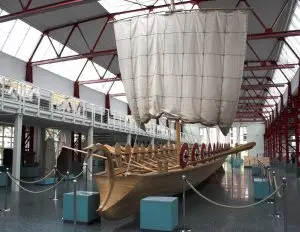
Reconstruction of a late Roman navis lusoria at Mainz
(Wiki Image By Martin Bahmann – Own work, CC BY-SA 3.0, https://commons.wikimedia.org/w/index.php?curid=2387575)
Extensive deforestation led to soil erosion and environmental degradation, impacting agriculture and the economy.
The Roman Empire’s insatiable demand for timber and agricultural land led to widespread deforestation, which had a significant environmental impact. It contributed to soil erosion, decreased agricultural productivity, and economic decline.
Examples:
| Purpose of Deforestation | Description | Impact |
| Construction and Fuel | Wood was essential for building houses, public buildings, ships, fortifications, and fuel. | – Large-scale logging, especially around urban centers and naval bases, led to significant deforestation. <br> – This tree cover loss made the soil vulnerable to erosion. |
| Agriculture | Forests were cleared to create farmland and pastures to meet the growing demand for food. | – Intensive farming practices and deforestation led to soil exhaustion and decreased fertility. <br> – This reduced agricultural yields and made the empire more susceptible to food shortages. |
| Mining | Wood was used extensively in mining operations for smelting and timber supports. | – Deforestation around mines contributed to soil erosion and water pollution, further degrading the environment. |
| Shipbuilding | The Roman navy required vast timber to construct and maintain its fleet. | – Deforestation along coastal areas and riverbanks impacted local ecosystems and contributed to soil erosion. |
Export to Sheets
Impact of Deforestation:
| Factor | Description |
| Soil Erosion | Tree cover loss increased soil erosion, reducing soil fertility and agricultural productivity. |
| Decreased Agricultural Yields | Soil erosion and degradation contributed to lower crop yields, making the empire more vulnerable to food shortages and economic instability. |
| Flooding | Deforestation increased the risk of flooding, as trees no longer absorbed rainfall and stabilized the soil. |
| Loss of Biodiversity | Deforestation led to the loss of habitat for wildlife and decreased biodiversity. |
| Climate Change | Deforestation contributes to climate change by reducing the amount of carbon dioxide absorbed from the atmosphere. |
Export to Sheets
Overall Impact:
Deforestation was a significant environmental problem in the Roman Empire, contributing to soil erosion, decreased agricultural productivity, and economic decline. While the Romans were skilled engineers and builders, their unsustainable use of natural resources weakened the empire and made it more vulnerable to other challenges. The environmental degradation caused by deforestation further exacerbated existing problems like food shortages, economic instability, and social unrest, ultimately contributing to the empire’s decline and fall.
Fall of the Western Roman Empire. Lead Poisoning: Some historians argue that lead poisoning from lead pipes and utensils contributed to health problems and a decline in cognitive abilities within the Roman population. Table. Examples.
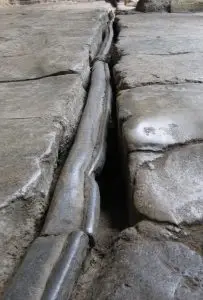
Uninscribed lead pipe with a folded seam, at the Roman thermae of Bath, England
(Wiki Image By Andrew Dunn – Self-photographed, CC BY-SA 2.0, https://commons.wikimedia.org/w/index.php?curid=606468)
Some historians argue that lead poisoning from lead pipes and utensils contributed to health problems and a decline in cognitive abilities within the Roman population.
The Romans pioneered the use of lead in various applications, including water pipes, utensils, and sweeteners. However, lead is a potent neurotoxin, and chronic exposure can lead to a range of health problems, including cognitive impairment. While the extent of its impact is debated, lead poisoning may have contributed to the decline of the Roman Empire.
Examples:
| Source of Lead | Description | Potential Impact |
| Water Pipes | Lead pipes were used extensively in Roman plumbing systems, potentially leaching lead into the water supply. | – Chronic lead exposure could have led to neurological problems, including reduced cognitive function, developmental delays in children, and even mental illness. |
| Utensils and Cookware | Lead was used to produce various utensils and cookware, potentially contaminating food and drink. | – Lead could leach into acidic foods and beverages, particularly when heated, increasing the risk of ingestion. |
| Cosmetics and Medicines | Lead was used in some cosmetics and medicines, potentially leading to absorption through the skin or ingestion. | – Exposure to lead-based cosmetics and medicines could have caused various health problems, including skin irritation, neurological damage, and even death. |
| Wine Sweeteners | “Defrutum,” a syrup made by boiling grape juice in lead pots, was used to sweeten wine. | – This practice could have introduced significant amounts of lead into the Roman diet, as wine was a standard beverage. |
Export to Sheets
Impact of Lead Poisoning:
| Factor | Description |
| Health Problems | Lead poisoning could have contributed to various health problems in the Roman population, including neurological disorders, infertility, and developmental problems in children. |
| Cognitive Decline | Chronic lead exposure could have led to a decline in cognitive abilities, affecting decision-making, problem-solving, and overall intellectual capacity. |
| Social Impact | Widespread health problems and cognitive decline could have weakened the social fabric and hindered economic productivity. |
| Political Impact | Lead poisoning may have affected the cognitive abilities of Roman leaders, potentially contributing to poor decision-making and political instability. |
Export to Sheets
Overall Impact:
While the extent of its impact is still debated, lead poisoning may have contributed to the Fall of the Western Roman Empire. Chronic exposure to lead could have led to widespread health problems, cognitive decline, and social and political instability. These, combined with other factors like economic decline, political corruption, and external threats, may have weakened the empire and contributed to its eventual collapse.
Note: It’s important to remember that lead poisoning was likely just one of many factors contributing to the decline of the Roman Empire. More research is needed to understand the extent of its impact fully.
Nerva, Trajan, Hadrian, Antoninus Pius, and Marcus Aurelius (96 to 180 AD): Five Good Emperors Compared the Fall of the Western Roman Empire. Examples. Tables.
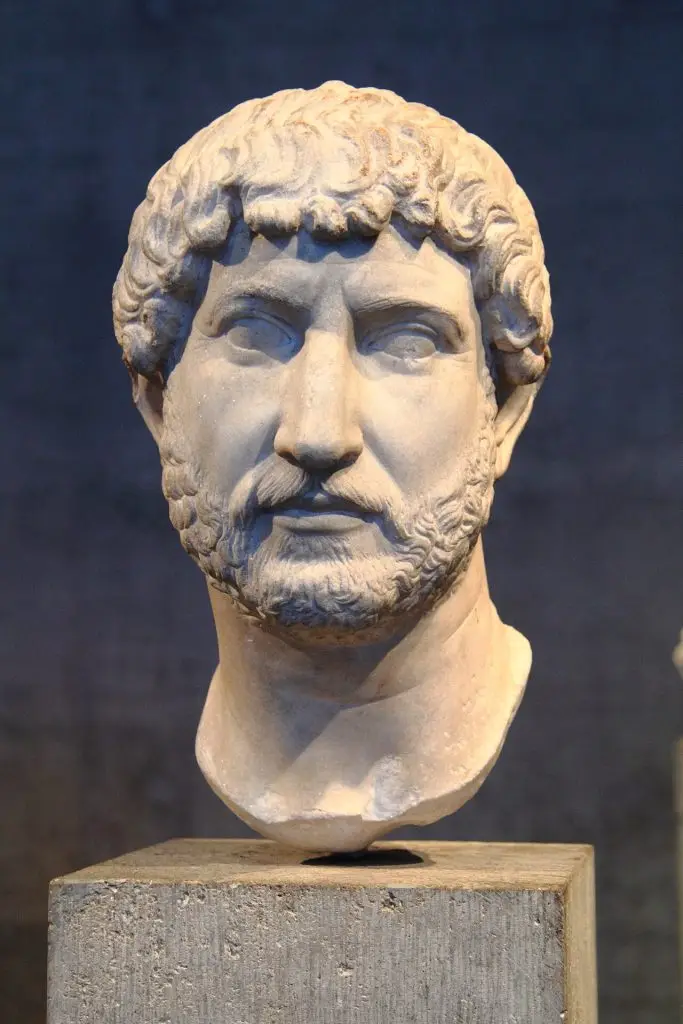
Bust of Hadrian, c. 130
(Wiki Image By Djehouty – Own work, CC BY-SA 4.0, https://commons.wikimedia.org/w/index.php?curid=85310985)
Okay, let’s organize the examples into tables to compare the Five Good Emperors and the Fall of the Western Roman Empire more clearly.
- Imperial Succession and Leadership
| Feature | Five Good Emperors | Example | Decline and Fall of the Western Roman Empire | Example |
| Succession | Adoptive principle based on merit | Nerva adopted Trajan, a skilled general, based on his competence. Trajan then adopted Hadrian. | Hereditary succession (mostly), military coups, and assassinations. | The “Year of the Four Emperors” (69 AD) and the Crisis of the Third Century (235-284 AD) saw numerous emperors rise and fall through violence. Emperor Diocletian, Constantine I, Maxentius, and Theodosius I were proclaimed emperor by their army. |
| Leadership | Generally competent, dedicated to the welfare of the empire | Hadrian traveled extensively, overseeing the administration and interacting with the people, demonstrating his commitment to good governance. | Often weak, corrupt, short-reigned, or focused on personal power. | Emperor Honorius was considered an ineffectual ruler, more interested in his pet chickens than governing. His mother controlled Emperor Valentinian III and was later assassinated. |
| Impact | Stability, smooth transitions of power, effective governance | Allowed the most qualified individuals to rule (at least in theory), leading to a period of peace and prosperity (Pax Romana). | Instability, civil wars, ineffective governance, and erosion of public trust. | Frequent power struggles weakened the empire, distracted it from pressing issues (barbarian invasions, economic problems), and made it difficult to implement long-term solutions. |
Export to Sheets
- Governance and Administration
| Feature | Five Good Emperors | Example | Decline and Fall of the Western Roman Empire | Example |
| Efficiency | Generally efficient and responsive to the needs of the people. | Hadrian reformed local administration during his travels, improving efficiency and addressing local concerns. | Increasingly inefficient, bloated, and unresponsive. | The bureaucracy became slow and cumbersome, making it difficult to collect taxes, implement policies, or respond to crises effectively. |
| Corruption | Relatively low levels of corruption compared to later periods. | Antoninus Pius was known for his honesty and integrity, setting a high standard for public service. | Rampant corruption at all levels of government. | Tax collectors (publicani) were notorious for extortion, and bribery was commonplace. Positions were often bought and sold. General Arbogast had Emperor Valentinian II killed and then appointed a puppet emperor. |
| Impact | Effective governance, public trust in the government, and improved quality of life. | Efficient administration allowed the empire to function smoothly, collect taxes, maintain infrastructure, and provide essential services. | Weakened state finances undermined the rule of law and bred resentment among the population. | Corruption diverted resources, made it difficult to implement policies, and eroded public confidence in the government, contributing to social unrest and instability. |
Export to Sheets
- Military Strength and Defense
| Feature | Five Good Emperors | Example | Decline and Fall of the Western Roman Empire | Example |
| Strength | Strong, disciplined, well-trained, and loyal. | Trajan’s successful campaigns in Dacia and Parthia demonstrated the Roman army’s strength and effectiveness. | Weakened, overstretched, undisciplined, and increasingly reliant on barbarian mercenaries (foederati). | The Battle of Adrianople (378 AD) highlighted the declining quality of the Roman army and its inability to defeat barbarian forces. |
| Effectiveness | Primarily used to defend borders and maintain peace (Pax Romana). | The army effectively defended the empire’s frontiers and suppressed internal revolts, maintaining order and stability. | Increasingly unable to defend the borders or suppress internal revolts. | The empire lost control of vast territories to barbarian groups like the Goths, Vandals, and Huns. Roman general Aetius relied on an army of Huns and Goths to defeat Attila. |
| Impact | Deterred foreign aggression, maintained internal order, and secured borders. | A strong military ensured the empire’s security, allowing trade to flourish and the economy to prosper. | Military defeats, territorial losses, increased insecurity, and a drain on the empire’s resources. | The empire became vulnerable to invasions, lost valuable provinces and resources, and was forced to make concessions to barbarian groups. |
Export to Sheets
- Economic Prosperity and Decline
| Feature | Five Good Emperors | Example | Decline and Fall of the Western Roman Empire | Example |
| Prosperity | Generally prosperous and stable economy. | Trajan’s public works programs (roads, aqueducts, public buildings) stimulated the economy and created jobs. | Economic decline, inflation, high taxes, and declining trade. | The debasement of the currency led to runaway inflation, eroding purchasing power and damaging the economy. |
| Trade | Flourishing trade within the empire and with other regions. | The empire’s unified currency, extensive road network, and relative peace facilitated trade. | Declining trade, both within the empire and with external partners. | Increased insecurity, internal conflict, and the breakdown of infrastructure disrupted trade routes and made it difficult for merchants to operate. |
| Impact | Economic growth, improved living standards, and resources for the state. | A strong economy provided the resources to maintain a powerful military, fund public works, and support a large population. | Economic hardship, social unrest, weakened state finances, inability to fund essential services, and the military. | Economic decline impoverished the population, reduced tax revenues, and made it difficult for the empire to pay its soldiers or maintain its defenses. |
Export to Sheets
- Social Cohesion and Division
| Feature | Five Good Emperors | Example | Decline and Fall of the Western Roman Empire | Example |
| Cohesion | Relative social harmony and a sense of shared Roman identity. | Antoninus Pius’s reign was known for its peace, tranquility, and general prosperity. | Increasing social divisions, economic hardship, and a decline in civic virtue. | The Bagaudae revolts in Gaul and Hispania were fueled by economic hardship and resentment towards the Roman elite. |
| Stability | Period of relative peace and stability (Pax Romana). | There were few major wars or internal conflicts during this era. | Frequent internal conflicts, civil wars, and social unrest. | The empire was plagued by power struggles, assassinations, and revolts, creating a climate of instability and insecurity. |
| Impact | Loyalty to the empire, social order, and a willingness to contribute to the state. | A stable and cohesive society was more resilient in the face of challenges and more likely to support the government. | Losing faith in the government increased crime and disorder, making the empire more vulnerable to internal and external threats. | Social divisions and unrest weakened the empire from within, making it harder to resist barbarian invasions or address other crises. |
Export to Sheets
- Territory
| Feature | Five Good Emperors | Example | Decline and Fall of the Western Roman Empire | Example |
| Territory | The empire is at its largest territorial extent. | At the end of Trajan’s reign, the Roman Empire controlled vast territories in Europe, North Africa, and the Middle East. | The Western Roman Empire continues to shrink and lose territory. | The Western Roman Empire loses control of its territory to the Vandals, Huns, Franks, Goths, and other groups. |
| Impact | A more extensive empire has more resources and manpower. | The Roman Empire was a formidable power. | A smaller empire has fewer resources and manpower. | The Western Roman Empire became progressively weaker. |
Export to Sheets
- Public Works
| Feature | Five Good Emperors | Example | Decline and Fall of the Western Roman Empire | Example |
| Public Works | The empire’s infrastructure is well-maintained. | The empire builds roads, aqueducts, bridges, and public buildings. Hadrian’s Wall is built. | Public works are neglected. | The empire’s infrastructure falls into disrepair. |
| Impact | The empire is easier to defend and administer. Trade is easier. | The Roman Empire was well-defended and prosperous. | It is more challenging to trade and nearly impossible to defend the empire’s borders. | The Western Roman Empire became weaker and more vulnerable to attack. |
Export to Sheets
- Border Control
| Feature | Five Good Emperors | Example | Decline and Fall of the Western Roman Empire | Example |
| Border Control | The empire can control its borders. | The Roman Army could patrol the empire’s borders effectively. | The empire is unable to control its borders effectively. | Barbarian groups could cross the border and raid Roman territory. |
| Impact | The empire is safe from outside attacks. | The Roman Empire is relatively peaceful. | The empire is vulnerable to outside attacks. | The Western Roman Empire is invaded several times. |
Export to Sheets
These tables provide a structured comparison, highlighting key differences between the era of the Five Good Emperors and the period of decline and fall. Remember that history is complex, and these are just some of the many factors that contributed to the fall of the Western Roman Empire. Other factors, such as disease and climate change, could also be considered.

